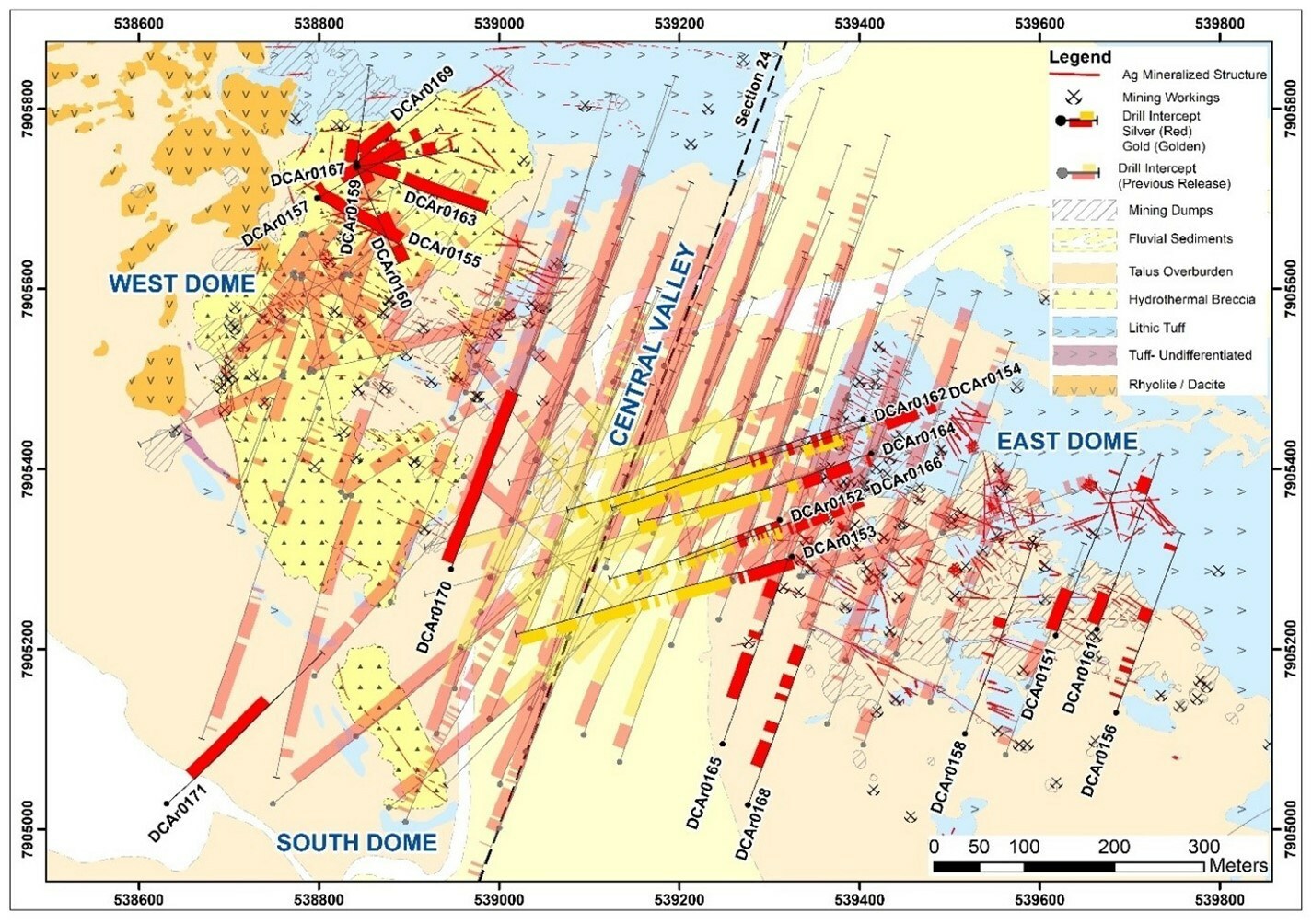
New Pacific Metals Corp (TSX:NUAG) has reported the assay results from the initial 21 boreholes of their Q1 2023 drilling project at the Carangas Silver-Gold Project in Bolivia. The first quarter of 2023 saw the successful completion of the drilling project, a follow-up to the previous year’s initiative at the Carangas site. Initially expected to involve 15,000 meters of diamond core drilling, the project was expanded to fill in and reach beyond areas drilled from 2021 to 2022. The operation kicked off as planned in January 2023, concluding with an impressive total of 17,623 meters drilled across 39 boreholes by the end of April. Each borehole intersected mineralization, with assay results from 21 holes available so far, and results from the remaining holes on the way.
For its premier mineral resource estimate, New Pacific teamed up with RPMGlobal Canada Limited, a consultancy providing technical services related to National Instrument 43-101 – Standards of Disclosure for Mineral Projects (“NI 43-101”). A qualified expert from RPMGlobal visited the site in March 2023, and with assay results from all boreholes soon to be available, the resource estimation is set to begin. The completed resource estimate is projected for release in Q3 2023.
The technical team is currently conducting in-depth surface geological mapping and sampling to sharpen drill targets beyond the previously drilled areas, focusing on the induced polarization (“IP”) chargeability anomalies. This interim mapping project is a strategic move in anticipation of the drilling project’s next phase, slated for H2 2023. The IP chargeability anomalies have shown a geophysical signature that aligns with the central valley’s drilled-off area, which is known to be rich in silver-gold mineralization—further solidifying the potential of the Carangas Project.
Highlights from the results are as follows:
DCAr0171 intersected a wide interval of silver mineralization measuring 205.6 m (76.8 m to 282.4 m) grading 123 g/t Ag, 0.44% Pb and 0.84% Zn, including 77.6 m (126.1 m to 203.7 m) grading 242 g/t Ag, 0.71% Pb and 1.30% Zn. This step-out hole was drilled through fluvial sediment cover to the southwest of the South Dome and implies that shallow silver mineralization remains open to the southwest, beyond the previously drilled West Dome-Central Valley-East Dome corridor.
DCAr0170 was drilled at the western limit of the Central Valley near the West Dome and intersected a wide interval of silver mineralization measuring 292.8 m starting near surface (9.2 m to 302 m) grading 58 g/t Ag, 0.39% Pb and 0.84% Zn, including 80.39 m (9.2 m to 89.59 m) grading 173 g/t Ag, 0.77% Pb and 1.08% Zn.
DCAr0154 intersected an interval of silver mineralization measuring 93.7 m (69.5 m to 163.2 m) grading 50 g/t Ag, 0.20% Pb and 0.53% Zn, including 13.05 m (72.4 m to 84.45 m) grading 280 g/t Ag, 0.36% Pb and 0.83% Zn. To depth, multiple intervals of gold mineralization were intersected, represented by 233.66 m (500.24 m to 733.9 m) grading 0.65 g/t Au and 107.1 m (774.24 m to 881.34 m) grading 0.84 g/t Au. This hole was drilled to test the eastern extension of gold mineralization at depth and the gold intervals in this hole indicate that gold mineralization remains open to the east.
DCAr0151 intersected an interval of silver mineralization measuring 66.76 m starting near surface (6.14 m to 72.9 m) grading 55 g/t Ag and 0.31% Pb, and a second silver interval of 3.63 m (266.13 m to 269.76 m) grading 215 g/t Ag, 0.45% Pb and 0.54% Zn. This hole was drilled in the upper portion of the East Dome.
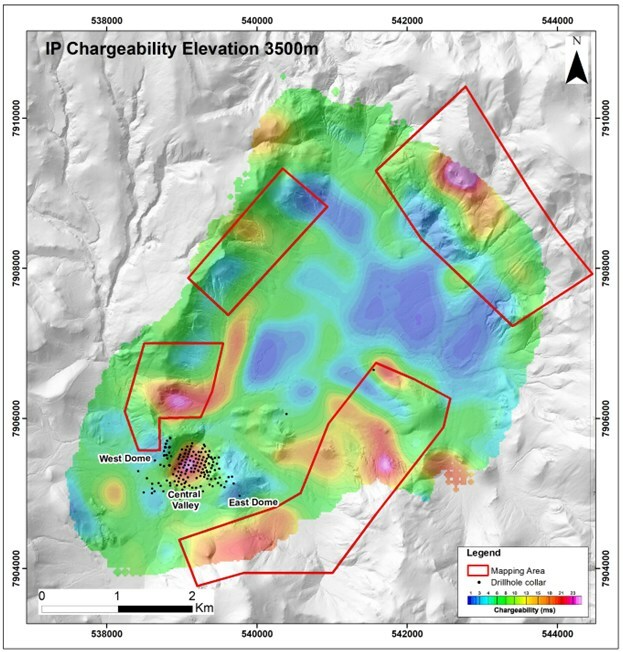
|
Table 1 Summary of Drill Intercepts |
||||||||||
|
Hole_ID |
Depth_from |
Depth_to |
Interval_m |
Ag_g/t |
Au_g/t |
Pb_% |
Zn_% |
Cu_% |
AgEq_g/t |
|
|
DCAr0151 |
6.14 |
72.90 |
66.76 |
55 |
0.31 |
0.04 |
0.01 |
67 |
||
|
233.25 |
234.49 |
1.24 |
130 |
0.03 |
0.03 |
0.02 |
134 |
|||
|
266.13 |
269.76 |
3.63 |
217 |
0.45 |
0.54 |
0.06 |
254 |
|||
|
DCAr0152 |
6.00 |
47.78 |
41.78 |
42 |
0.40 |
0.25 |
0.01 |
63 |
||
|
69.25 |
125.28 |
56.03 |
21 |
0.38 |
0.94 |
63 |
||||
|
140.14 |
148.35 |
8.21 |
11 |
0.37 |
0.92 |
53 |
||||
|
177.30 |
213.11 |
35.81 |
9 |
0.03 |
0.44 |
0.82 |
0.03 |
54 |
||
|
242.70 |
302.00 |
59.30 |
16 |
0.18 |
0.21 |
0.58 |
0.03 |
57 |
||
|
311.78 |
315.92 |
4.14 |
1 |
0.97 |
0.01 |
0.07 |
73 |
|||
|
325.27 |
365.29 |
40.02 |
6 |
0.51 |
0.08 |
0.27 |
0.03 |
56 |
||
|
378.20 |
422.32 |
44.12 |
5 |
0.59 |
0.01 |
0.04 |
0.04 |
53 |
||
|
436.71 |
483.92 |
47.21 |
2 |
0.61 |
0.01 |
0.04 |
0.02 |
49 |
||
|
510.00 |
517.50 |
7.50 |
0 |
0.78 |
0.03 |
58 |
||||
|
523.50 |
531.90 |
8.40 |
6 |
1.15 |
0.01 |
0.04 |
0.09 |
99 |
||
|
576.10 |
597.17 |
21.07 |
1 |
0.01 |
0.03 |
0.82 |
31 |
|||
|
650.00 |
682.82 |
32.82 |
25 |
0.22 |
0.05 |
0.02 |
0.08 |
51 |
||
|
697.84 |
748.00 |
50.16 |
3 |
0.89 |
0.01 |
0.03 |
0.13 |
81 |
||
|
787.50 |
802.42 |
14.92 |
10 |
0.87 |
0.01 |
0.41 |
115 |
|||
|
DCAr0153 |
2.14 |
138.37 |
136.23 |
26 |
0.22 |
0.56 |
0.01 |
53 |
||
|
150.80 |
165.36 |
14.56 |
7 |
0.62 |
1.19 |
0.02 |
67 |
|||
|
191.45 |
356.50 |
165.05 |
6 |
0.27 |
0.34 |
0.80 |
0.01 |
63 |
||
|
380.74 |
386.00 |
5.26 |
6 |
0.61 |
0.01 |
0.07 |
0.06 |
59 |
||
|
409.00 |
422.00 |
13.00 |
19 |
0.14 |
0.15 |
0.28 |
0.15 |
58 |
||
|
440.70 |
464.00 |
23.30 |
8 |
0.40 |
0.02 |
0.04 |
0.16 |
55 |
||
|
482.22 |
610.15 |
127.93 |
5 |
0.59 |
0.02 |
0.03 |
0.04 |
53 |
||
|
659.52 |
720.90 |
61.38 |
6 |
0.30 |
0.04 |
0.21 |
0.17 |
53 |
||
|
755.70 |
833.67 |
77.97 |
4 |
0.08 |
0.07 |
0.51 |
0.02 |
31 |
||
|
DCAr0154 |
16.30 |
43.16 |
26.86 |
14 |
0.37 |
0.09 |
28 |
|||
|
69.50 |
163.20 |
93.70 |
50 |
0.20 |
0.53 |
0.02 |
75 |
|||
|
incl. |
72.40 |
85.45 |
13.05 |
280 |
0.36 |
0.83 |
0.01 |
319 |
||
|
209.50 |
219.25 |
9.75 |
6 |
0.09 |
0.97 |
0.60 |
61 |
|||
|
289.95 |
368.36 |
78.41 |
4 |
0.17 |
0.22 |
0.40 |
36 |
|||
|
378.10 |
408.00 |
29.90 |
5 |
0.16 |
0.17 |
0.33 |
32 |
|||
|
452.00 |
460.12 |
8.12 |
5 |
0.10 |
0.13 |
0.36 |
28 |
|||
|
500.24 |
733.90 |
233.66 |
8 |
0.65 |
0.01 |
0.13 |
59 |
|||
|
747.00 |
756.50 |
9.50 |
2 |
0.41 |
0.00 |
0.01 |
32 |
|||
|
774.24 |
881.34 |
107.10 |
5 |
0.84 |
0.01 |
0.01 |
65 |
|||
|
DCAr0155 |
1.84 |
137.25 |
135.41 |
11 |
0.37 |
0.37 |
0.01 |
35 |
||
|
DCAr0156 |
24.00 |
28.28 |
4.28 |
22 |
0.82 |
0.07 |
0.07 |
56 |
||
|
44.58 |
48.60 |
4.02 |
38 |
1.87 |
0.07 |
0.01 |
97 |
|||
|
65.00 |
74.00 |
9.00 |
45 |
0.47 |
0.02 |
59 |
||||
|
81.37 |
88.10 |
6.73 |
25 |
0.61 |
0.02 |
0.01 |
44 |
|||
|
102.50 |
105.00 |
2.50 |
26 |
0.19 |
0.05 |
0.01 |
34 |
|||
|
150.85 |
173.50 |
22.65 |
4 |
0.48 |
0.12 |
0.01 |
23 |
|||
|
270.45 |
278.80 |
8.35 |
56 |
0.39 |
0.04 |
0.01 |
70 |
|||
|
DCAr0157 |
3.23 |
15.42 |
12.19 |
18 |
0.29 |
0.02 |
0.01 |
29 |
||
|
41.97 |
139.12 |
97.15 |
16 |
0.56 |
0.03 |
34 |
||||
|
159.50 |
172.32 |
12.82 |
1.01 |
1.34 |
0.01 |
76 |
||||
|
DCAr0158 |
125.00 |
129.50 |
4.50 |
31 |
0.14 |
0.50 |
0.01 |
52 |
||
|
172.45 |
187.38 |
14.93 |
27 |
0.21 |
0.30 |
0.01 |
44 |
|||
|
240.38 |
241.84 |
1.46 |
62 |
0.07 |
0.12 |
68 |
||||
|
273.50 |
275.00 |
1.50 |
57 |
0.15 |
0.15 |
0.06 |
72 |
|||
|
299.00 |
303.00 |
4.00 |
67 |
0.10 |
0.11 |
0.06 |
79 |
|||
|
DCAr0159 |
5.00 |
39.10 |
34.10 |
35 |
0.57 |
0.03 |
53 |
|||
|
DCAr0160 |
6.70 |
28.20 |
21.50 |
31 |
0.26 |
0.02 |
0.01 |
39 |
||
|
75.50 |
109.89 |
34.39 |
23 |
0.27 |
0.04 |
0.01 |
33 |
|||
|
125.00 |
152.00 |
27.00 |
19 |
0.36 |
1.32 |
0.02 |
77 |
|||
|
DCAr0161 |
6.90 |
57.90 |
51.00 |
59 |
0.16 |
0.05 |
0.01 |
67 |
||
|
153.50 |
155.00 |
1.50 |
116 |
0.09 |
0.06 |
0.04 |
125 |
|||
|
225.50 |
252.50 |
27.00 |
18 |
0.05 |
0.11 |
0.01 |
24 |
|||
|
DCAr0162 |
75.47 |
79.39 |
3.92 |
31 |
0.76 |
1.27 |
97 |
|||
|
97.20 |
125.35 |
28.15 |
31 |
0.21 |
0.65 |
0.02 |
61 |
|||
|
136.27 |
154.20 |
17.93 |
9 |
0.31 |
0.78 |
0.05 |
50 |
|||
|
207.50 |
225.00 |
17.50 |
5 |
0.04 |
0.47 |
0.54 |
39 |
|||
|
287.10 |
304.31 |
17.21 |
7 |
0.18 |
0.53 |
0.72 |
0.02 |
62 |
||
|
321.22 |
329.88 |
8.66 |
3 |
0.08 |
0.40 |
0.96 |
53 |
|||
|
392.87 |
399.50 |
6.63 |
18 |
0.56 |
0.13 |
0.19 |
0.08 |
77 |
||
|
427.45 |
600.35 |
172.90 |
14 |
0.97 |
0.06 |
0.02 |
0.09 |
94 |
||
|
631.12 |
645.17 |
14.05 |
6 |
0.81 |
0.01 |
0.02 |
0.06 |
70 |
||
|
658.20 |
663.95 |
5.75 |
0 |
1.29 |
0.01 |
93 |
||||
|
673.67 |
717.87 |
44.20 |
2 |
1.08 |
0.00 |
0.01 |
0.05 |
85 |
||
|
734.00 |
754.50 |
20.50 |
2 |
0.71 |
0.01 |
0.01 |
0.03 |
57 |
||
|
796.40 |
819.70 |
23.30 |
1 |
0.84 |
0.03 |
0.02 |
63 |
|||
|
DCAr0163 |
5.60 |
59.50 |
53.90 |
22 |
0.46 |
0.05 |
0.01 |
38 |
||
|
70.00 |
197.25 |
127.25 |
37 |
0.63 |
0.12 |
0.01 |
60 |
|||
|
incl. |
137.40 |
149.30 |
11.90 |
123 |
0.82 |
0.24 |
0.01 |
156 |
||
|
incl. |
179.90 |
195.90 |
16.00 |
198 |
0.55 |
0.23 |
0.01 |
222 |
||
|
DCAr0164 |
7.50 |
19.50 |
12.00 |
14 |
0.13 |
0.22 |
25 |
|||
|
77.65 |
164.60 |
86.95 |
12 |
0.14 |
0.48 |
0.02 |
34 |
|||
|
187.00 |
252.97 |
65.97 |
4 |
0.03 |
0.31 |
0.48 |
31 |
|||
|
271.90 |
308.60 |
36.70 |
5 |
0.15 |
0.44 |
0.74 |
0.01 |
54 |
||
|
373.80 |
406.63 |
32.83 |
6 |
0.07 |
0.12 |
0.48 |
0.02 |
33 |
||
|
423.40 |
628.10 |
204.70 |
8 |
0.64 |
0.03 |
0.08 |
0.04 |
61 |
||
|
683.50 |
713.75 |
30.25 |
2 |
0.61 |
0.01 |
0.02 |
0.05 |
52 |
||
|
767.00 |
821.24 |
54.24 |
6 |
1.61 |
0.00 |
0.01 |
0.14 |
135 |
||
|
DCAr0165 |
72.27 |
144.80 |
72.53 |
21 |
0.21 |
0.76 |
53 |
|||
|
170.20 |
180.70 |
10.50 |
7 |
0.05 |
0.45 |
0.01 |
24 |
|||
|
235.56 |
263.40 |
27.84 |
6 |
0.30 |
0.81 |
42 |
||||
|
DCAr0166 |
1.00 |
53.10 |
52.10 |
13 |
0.25 |
0.27 |
30 |
|||
|
65.00 |
69.00 |
4.00 |
56 |
0.18 |
0.55 |
80 |
||||
|
88.00 |
146.90 |
58.90 |
19 |
0.26 |
0.75 |
53 |
||||
|
162.01 |
236.80 |
74.79 |
10 |
0.03 |
0.29 |
0.50 |
0.01 |
38 |
||
|
251.50 |
314.87 |
63.37 |
6 |
0.16 |
0.53 |
0.96 |
0.01 |
67 |
||
|
330.78 |
347.08 |
16.30 |
4 |
0.02 |
0.22 |
0.48 |
0.05 |
33 |
||
|
390.77 |
414.50 |
23.73 |
3 |
0.22 |
0.08 |
0.18 |
0.04 |
31 |
||
|
419.00 |
428.00 |
9.00 |
1 |
0.61 |
0.00 |
0.03 |
0.01 |
47 |
||
|
451.90 |
466.57 |
14.67 |
2 |
1.05 |
0.09 |
0.27 |
0.03 |
92 |
||
|
476.70 |
485.65 |
8.95 |
10 |
2.54 |
0.05 |
0.07 |
0.04 |
199 |
||
|
511.70 |
515.56 |
3.86 |
14 |
1.49 |
0.03 |
0.03 |
0.14 |
136 |
||
|
611.50 |
620.90 |
9.40 |
7 |
0.15 |
0.03 |
0.76 |
0.06 |
50 |
||
|
700.70 |
709.15 |
8.45 |
1 |
0.10 |
0.01 |
1.01 |
0.01 |
43 |
||
|
774.75 |
785.80 |
11.05 |
4 |
0.72 |
0.00 |
0.03 |
0.18 |
75 |
||
|
791.20 |
798.10 |
6.90 |
2 |
0.32 |
0.00 |
0.02 |
0.24 |
51 |
||
|
DCAr0167 |
5.00 |
73.30 |
68.30 |
25 |
0.56 |
0.06 |
44 |
|||
|
98.30 |
119.00 |
20.70 |
10 |
0.66 |
0.11 |
33 |
||||
|
140.00 |
143.91 |
3.91 |
9 |
1.16 |
0.09 |
0.01 |
46 |
|||
|
DCAr0168 |
62.75 |
104.80 |
42.05 |
18 |
0.30 |
0.58 |
47 |
|||
|
120.80 |
138.60 |
17.80 |
33 |
0.16 |
0.61 |
59 |
||||
|
175.87 |
186.00 |
10.13 |
19 |
0.12 |
0.35 |
34 |
||||
|
197.30 |
219.44 |
22.14 |
8 |
0.36 |
0.71 |
0.01 |
44 |
|||
|
237.70 |
269.80 |
32.10 |
28 |
0.97 |
1.37 |
0.08 |
109 |
|||
|
DCAr0169 |
14.80 |
74.67 |
59.87 |
31 |
0.82 |
0.06 |
57 |
|||
|
DCAr0170 |
9.20 |
302.00 |
292.80 |
58 |
0.39 |
0.84 |
0.02 |
99 |
||
|
incl. |
9.20 |
89.59 |
80.39 |
173 |
0.77 |
1.08 |
0.05 |
236 |
||
|
DCAr0171 |
76.80 |
282.40 |
205.60 |
123 |
0.02 |
0.44 |
0.84 |
0.02 |
167 |
|
|
incl. |
126.10 |
203.70 |
77.60 |
242 |
0.01 |
0.71 |
1.30 |
0.03 |
310 |
|
|
311.35 |
406.35 |
95.00 |
9 |
0.36 |
0.92 |
0.02 |
57 |
|||
|
Notes: |
|
|
1. |
Drill location, altitude, azimuth, and dip of drill holes are provided in Table 2 |
|
2. |
Drill intercept is core length, and grade is length weighted. True width of mineralization is unknown due to early stage of exploration without adequate drill data. |
|
3. |
Calculation of silver equivalent (“AgEq”) is based on the long-term median of the August 2021 Street Consensus Commodity Price Forecasts, which are US$22.50/oz for Ag, US$0.95/lb for Pb, US$1.10/lb for Zn, US$3.40/lb for Cu, and US$1,600/oz for Au. The formula used for the AgEq calculation is as follows: AgEq = Ag g/t + Pb g/t * 0.0029 + Zn g/t * 0.00335 + Cu g/t * 0.01036 + Au g/t * 71.1111. This calculation assumes 100% recovery. |
|
4. |
A cut-off of 20 g/t AgEq is applied to calculate the length-weighted intercept. At times, samples lower than 20 g/t AgEq may be included in the calculation of consolidation of mineralized intercepts. |
|
Table 2 Summary of Drill Holes of Discovery Drill Program of Carangas Project |
|||||||
|
Hole_id |
Easting |
Northing |
Altitude |
Depth_m |
Azimuth (°) |
Dip (°) |
Target |
|
DCAr0151 |
539617.75 |
7905215.10 |
4013.81 |
300.00 |
20 |
-45 |
ED |
|
DCAr0152 |
539311.30 |
7905343.30 |
3911.21 |
821.00 |
252 |
-75 |
CV |
|
DCAr0153 |
539324.98 |
7905302.65 |
3917.54 |
836.00 |
252 |
-67 |
CV |
|
DCAr0154 |
539487.76 |
7905479.04 |
3921.69 |
900.00 |
249 |
-66 |
CV |
|
DCAr0155 |
538797.69 |
7905700.86 |
4063.33 |
140.00 |
120 |
-40 |
WD |
|
DCAr0156 |
539684.64 |
7905129.41 |
4036.00 |
302.00 |
20 |
-45 |
ED |
|
DCAr0157 |
538799.21 |
7905701.13 |
4063.35 |
206.00 |
60 |
-40 |
WD |
|
DCAr0158 |
539517.04 |
7905105.86 |
3969.15 |
323.00 |
20 |
-45 |
ED |
|
DCAr0159 |
538841.19 |
7905736.01 |
4068.83 |
152.00 |
7 |
-40 |
WD |
|
DCAr0160 |
538841.30 |
7905734.87 |
4068.79 |
152.00 |
156 |
-40 |
WD |
|
DCAr0161 |
539663.65 |
7905221.91 |
4023.46 |
293.00 |
20 |
-45 |
ED |
|
DCAr0162 |
539403.94 |
7905455.30 |
3924.08 |
848.00 |
252 |
-67 |
CV |
|
DCAr0163 |
538842.50 |
7905735.25 |
4068.85 |
200.00 |
110 |
-40 |
WD |
|
DCAr0164 |
539412.79 |
7905417.33 |
3930.76 |
821.00 |
252 |
-70 |
CV |
|
DCAr0165 |
539247.76 |
7905094.61 |
3908.82 |
302.00 |
20 |
-45 |
ED |
|
DCAr0166 |
539400.87 |
7905371.39 |
3935.30 |
848.00 |
247 |
-75 |
CV |
|
DCAr0167 |
538843.04 |
7905735.85 |
4068.79 |
152.00 |
81 |
-40 |
WD |
|
DCAr0168 |
539276.07 |
7905026.84 |
3910.53 |
302.00 |
20 |
-45 |
ED |
|
DCAr0169 |
538841.68 |
7905740.16 |
4068.79 |
152.00 |
50 |
-40 |
WD |
|
DCAr0170 |
538946.49 |
7905288.56 |
3905.72 |
302.00 |
20 |
-45 |
WD |
|
DCAr0171 |
538631.00 |
7905028.49 |
3905.09 |
420.00 |
48 |
-59 |
SD |
|
Note: |
1. Drill collar coordinate system is WGS1984 UTM Zone 19S |
||||||
|
2. Coordinate of drill collar is picked with Real Time Kinematics (RTK) GPS except hole DCAr0036 which is by handheld GPS |
|||||||
|
3. CV – Central Valley; WD – West Dome; ED – East Dome; SD – South Dome |
|||||||
The above references an opinion and is for information purposes only. It is not intended to be investment advice. Seek a licensed professional for investment advice. The author is not an insider or shareholder of any of the companies mentioned above.
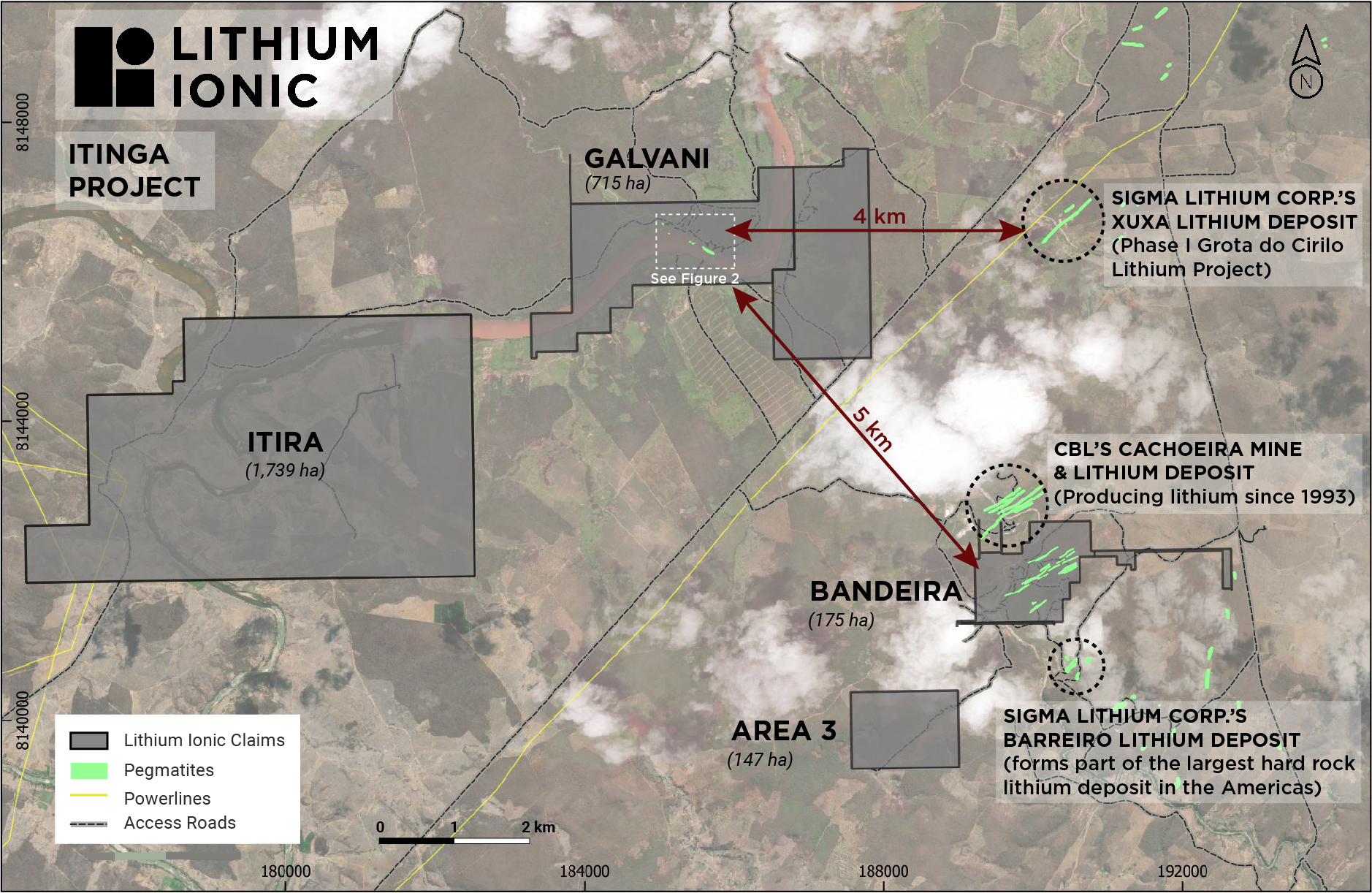
Lithium Ionic (TSXV:LTH) has reported further assay results from the Galvani target, a component of the company’s nearly completed 30,000-metre delineation drill program. This project is anticipated to result in an initial NI 43-101 compliant mineral resource estimate for both the Bandeira and Galvani targets by the second quarter of 2023.
Blake Hylands, P.Geo., CEO of Lithium Ionic, commented in a press release: “These latest results further confirm the scale and continuity of the large spodumene-bearing pegmatite dykes at this target. The results from the initial drilling program at Galvani and Bandeira have been tremendously successful, and our team is confident that the upcoming mineral resource estimate will deliver scale and high-grade, that will form the basis for significant future growth.”
So far, Lithium Ionic has managed to carry out 28,400 metres of drilling at the Bandeira and Galvani sites and is now wrapping up the final drill holes before the data cut-off for inclusion in the mineral resource estimate.
The Galvani claims are conveniently located around 5 kilometres to the northwest of Lithium Ionic’s Bandeira property and Companhia Brasileira de Lítio’s (CBL) Cachoeira lithium mine. They’re also approximately 4 kilometres west of Sigma Lithium’s large Xuxa lithium deposit (refer to Figure 1).
Currently, Lithium Ionic is the second-largest mineral rights holder in the area, with control over 14,182 hectares in this budding hard rock lithium production district. The Galvani and Bandeira properties, set to be the focus of the initial mineral resource estimate, cover only 872 hectares of this vast land package.
To complete the initial NI 43-101 mineral resource estimate, the company has partnered with SGS Canada (“SGS”), an internationally recognized firm with expertise in the estimation and modelling of mineral deposits. Notably, SGS has had firsthand experience with lithium deposits in the region, including those belonging to Sigma Lithium Corp.
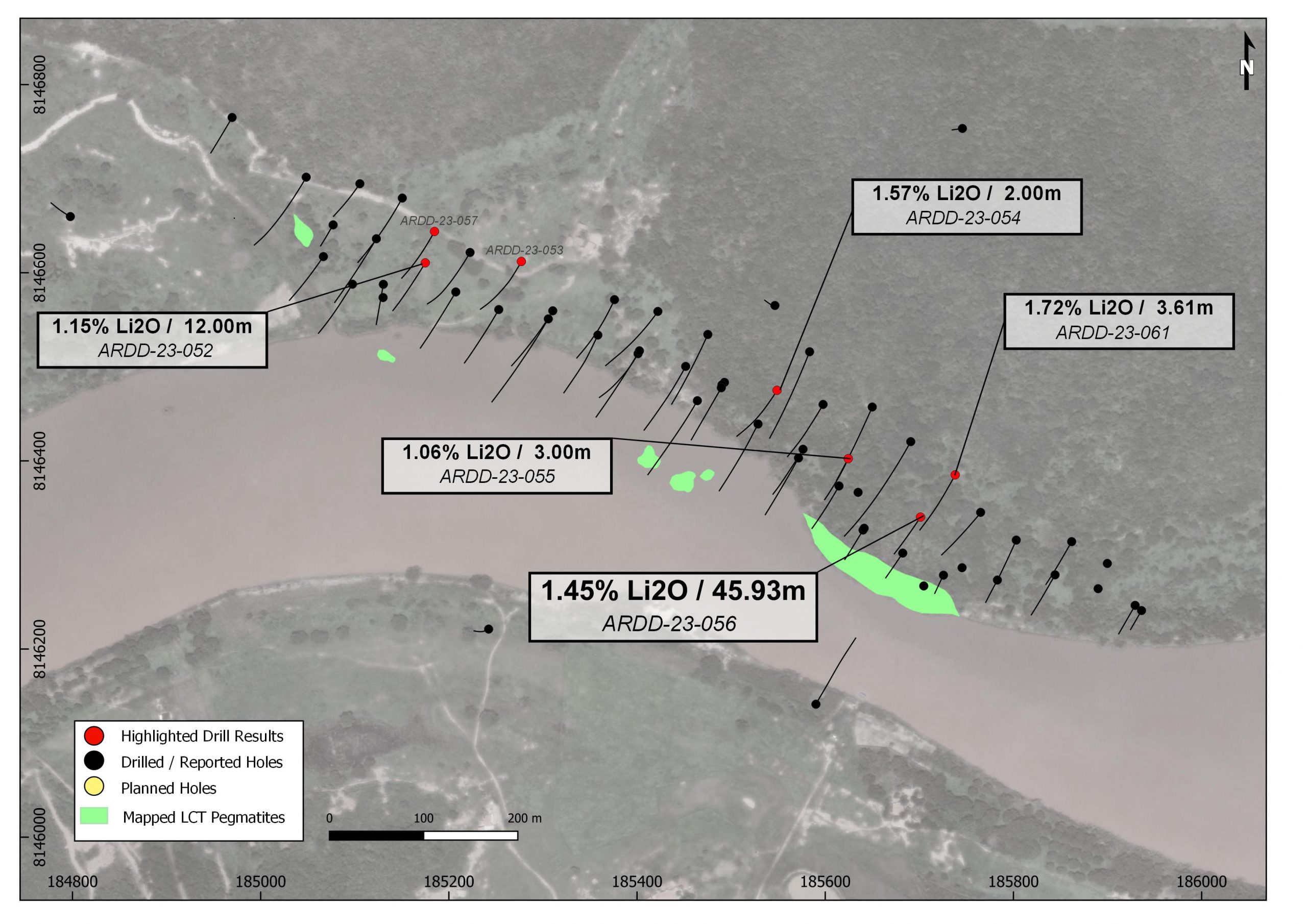
Table 1. Galvani Drill Results
| Hole ID | Az | Dip | From | To | Metres | Li2O (%) |
| ARDD-23-52 | 210 | -45 | 54.14 | 66.14 | 12.00 | 1.15 |
| ARDD-23-54 | 210 | -60 | 113.10 | 115.10 | 2.00 | 1.57 |
| ARDD-23-55 | 210 | -65 | 97.18 | 100.18 | 3.00 | 1.06 |
| ARDD-23-56 | 210 | -60 | 28.07 | 74.00 | 45.93 | 1.45 |
| ARDD-23-61 | 205 | -55 | 99.88 | 103.49 | 3.61 | 1.72 |
*Assays pending for ARDD-23-58 to ARDD-23-60;
No significant values in holes ARDD-23-53 and ARDD-23-57
Lithium Ionic also announced the formation of Valitar Participacoes S.A. (“Valitar”), a special purpose vehicle (“SPV”). Lithium Ionic, through Valitar, plans to acquire surface rights over its mining claims that it deems have high mining potential. As per Brazilian law, the owner of surface rights on a mining claim is entitled to 1% of the mineral net revenue from the mining of lithium on that claim.
Valitar is a Brazilian firm and Lithium Ionic, via its wholly-owned subsidiary, MGLIT Empreendimentos Ltda. (“MGLIT”), owns 100% of the preferred shares of Valitar. These Preferred Shares allow MGLIT to reap the economic benefits generated by Valitar.
MGLIT has signed a loan agreement with Valitar to supply Valitar with up to R$10 million (approximately USD$2 million) for the acquisition of the necessary surface rights over Lithium Ionic’s mining claims. This Loan, which has a three-year term, is unsecured and carries an annual interest rate of 1%. As per Brazilian law, rural land must be owned by a Brazilian resident, thus the common shares of Valitar are beneficially owned by an officer of Lithium Ionic who resides in Brazil. Consequently, the Loan is considered a “related party transaction” as per Multilateral Instrument 61-101 – Protection of Minority Security Holders in Special Transactions (“MI 61-101”). Lithium Ionic is relying on exemptions from the formal valuation requirements of MI 61-101 pursuant to section 5.5(a) and the minority shareholder approval requirements of MI 61-101 pursuant to section 5.7(1)(a), given that the fair market value of the Loan does not exceed 25% of the Company’s market capitalization.
The above references an opinion and is for information purposes only. It is not intended to be investment advice. Seek a licensed professional for investment advice. The author is not an insider or shareholder of any of the companies mentioned above.
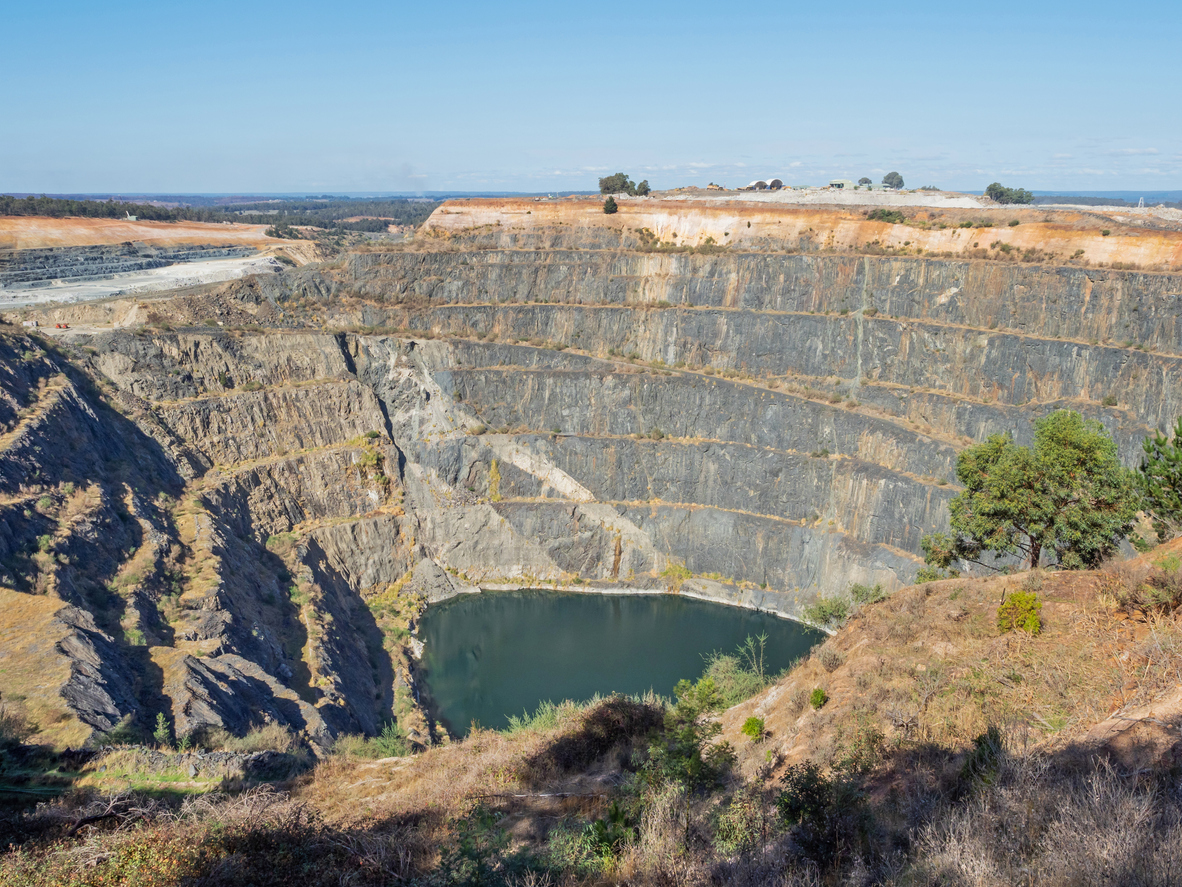
In the era of climate change and the push for sustainable transportation, the electric vehicle (EV) revolution has finally gained momentum. As more countries and consumers recognize the need to reduce carbon emissions, the demand for EVs has skyrocketed.
Behind this clean energy transition lies a critical component: lithium. Aaron Wolfe, a long-time investor in mining companies, calls lithium “the lifeblood” of the electric vehicle industry, and one that will only increase in significance over the foreseeable future.
As countries around the world move away from fossil fuels, access to EV resources like lithium will become crucial to the energy marketplace, Wolfe said. Just recently, Exxon Mobil announced plans to begin lithium mining as it eyes a future of waning demand for oil.
“As the demand for EVs continues to surge, so does the need for lithium,” said Wolfe, who developed lithium assets in Argentina and Nevada. “To meet the growing demand, we must develop lithium resources that can ensure a sustainable supply chain.”
Wolfe’s experience in developing lithium assets has allowed him to witness firsthand the critical role mining plays in driving the electric vehicle revolution.

Lithium, a lightweight metal, is crucial for the production of lithium-ion batteries, which power most modern electric vehicles and consumer electronics. These high-performance batteries offer longer range, faster charging times, and increased energy storage capacity compared to traditional lead-acid batteries. The unique properties of lithium make it the ideal choice for storing and delivering energy efficiently — which is why it has become the backbone of the EV industry.
Both price and demand continue to grow, as MiningFeeds has reported. For many observers, 2022 marked a potential turning point: EVs surpassed 5% of all auto sales in the US, and global EV sales are on track to more than triple by 2025, according to BloombergNEF.
But for the revolution to actually happen, the EV industry will need much more of the metal than is currently available.
For lithium-mining’s hotspots, look no further than Argentina and the state of Nevada in the US, Wolfe said.
Argentina boasts one of the largest lithium reserves globally, primarily located in the lithium-rich brine deposits of the “Lithium Triangle” region. Nevada, on the other hand, is known for its lithium extraction from lithium brine assets in the Clayton Valley region and more broadly from hard rock deposits. Wolfe’s involvement in the development of lithium assets in Nevada has allowed him to witness the tremendous potential of these resources in meeting the increasing demand for EV batteries, especially made-in-America battery solutions he said.
“We can expect regions of the world with rich lithium resources to become increasingly important as demand surges in the coming years,” Wolfe said.
While lithium mining is crucial for the EV industry, it is not without its challenges.
Sustainable and responsible mining practices are essential to minimize environmental impact and ensure local communities’ well-being. Wolfe reinforced the need for ethical mining practices.
“We have a responsibility to extract lithium in an environmentally conscious manner, working closely with all the local stakeholders to mitigate any potential impacts,” Wolfe said.
It helps that innovations and advancements in technology have repeatedly improved the efficiency and sustainability of lithium extraction processes. From reducing water consumption to optimizing energy usage, the mining industry is making changes to minimize its environmental footprint, Wolfe said.
“Innovation and responsible mining practices go hand in hand in creating a sustainable future for the lithium mining sector and the industry it powers,” he added.
As the electric vehicle revolution gains momentum, the importance of lithium mining cannot be overstated, and the push towards a sustainable future in transportation, powered by the surge in electric vehicles, hinges critically on lithium mining. Aaron Wolfe has underscored lithium as the indispensable ‘lifeblood’ of the EV industry, and lithium mining’s pivotal part in this seismic shift will only be amplified in the coming years.
The above references an opinion and is for information purposes only. It is not intended to be investment advice. Seek a licensed professional for investment advice. The author is not an insider or shareholder of any of the companies mentioned above.
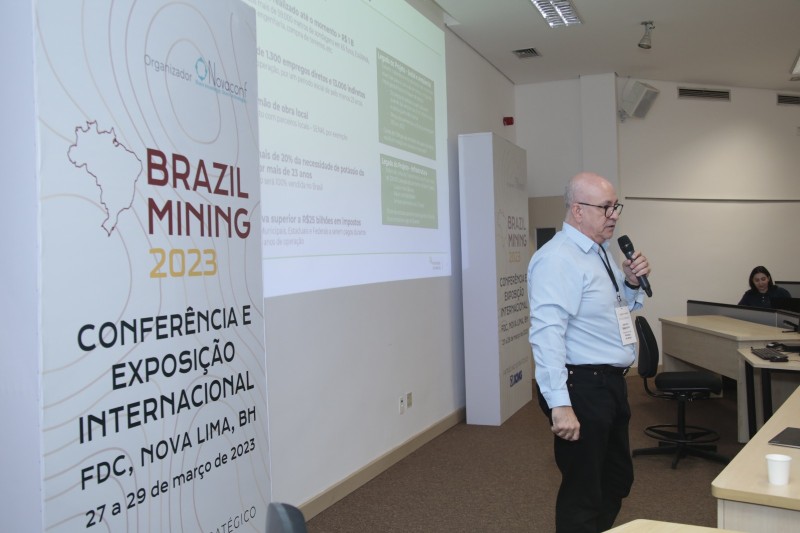
At the Brazil Mining 2023 International Conference and Exhibition held in Nova Lima, Adriano Espeschit, president of Potássio do Brasil (PdB), a subsidiary of Brazil Potash (BPC) delivered a lecture on “Food security: Brazil and global potash demand.” The conference, organized by Novaconf, attracted roughly 70 participants from various fields in the mining industry to discuss innovations, forge partnerships, and explore investment projects in Brazil.
Potássio do Brasil’s attendance at the conference aimed to showcase the Potássio Autazes Project and emphasize its significance for Brazil’s agricultural sector. Espeschit highlighted that the project would be “a milestone in the productive sector in Brazil” by bolstering agribusiness and providing food security. Furthermore, it would promote sustainable development in Autazes, the municipality where the project will be implemented.
The company is currently awaiting the Installation License (LI) from the Instituto of Environmental Protection of Amazonas (Ipaam) to begin constructing facilities and extracting potassium chloride from the sylvinite mine in Autazes, located 112 km from Manaus. The company has already received the Preliminary License (LP) from the same organization.
At a recent meeting of the Board of Directors of the Superintendence of the Manaus Free Trade Zone (Suframa), Vice President of the Republic and Minister of Development, Industry, Commerce and Services (Mdic), Geraldo Alckmin, pledged the government’s support for the project. Brazil is a leading global food producer and a major importer of fertilizers, particularly potassium chloride. Espeschit revealed that Brazil imports 98% of the potassium used in its agriculture.
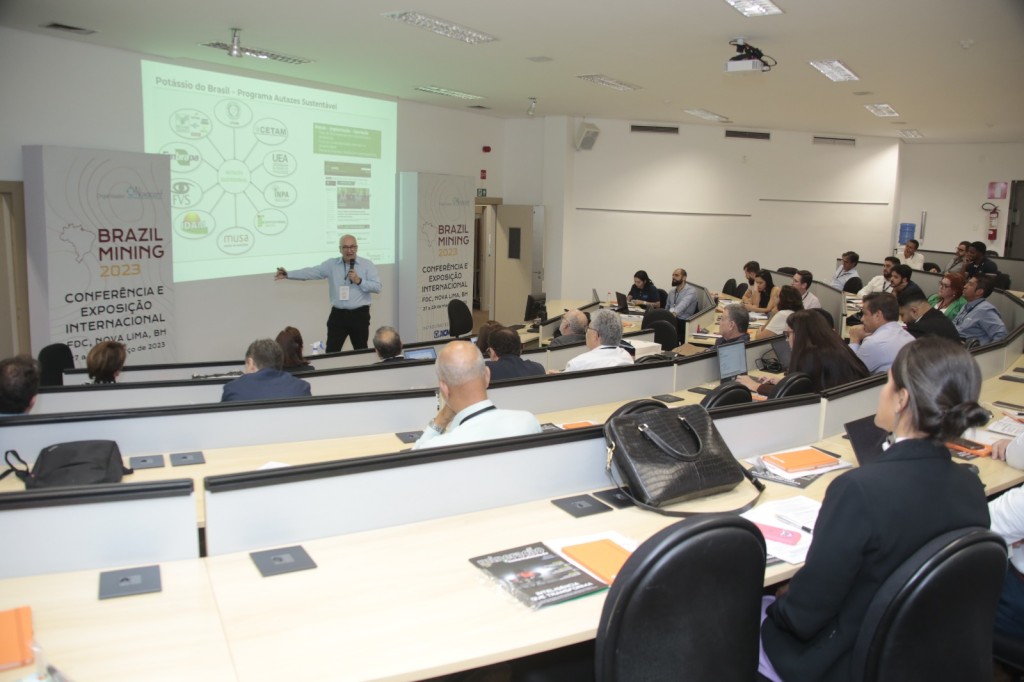
Espeschit added that potassium would be extracted 800 meters underground and the company’s facilities would be built on previously used pastureland, avoiding deforestation of native forests. He emphasized the company’s commitment to reforesting an area ten times larger than the one occupied by its facilities.
The above references an opinion and is for information purposes only. It is not intended to be investment advice. Seek a licensed professional for investment advice. The author is not an insider or shareholder of any of the companies mentioned above.
In an effort to further its mission of community development and environmental sustainability, Brazil Potash, through its subsidiary, Potássio do Brasil, has generously provided 5,766 seedlings of various kinds to the Amazonas state government. The seedlings, which include fruit, forest, ornamental, and medicinal varieties, were cultivated in the company’s nursery situated in the Urucurituba village in the Autazes municipality.
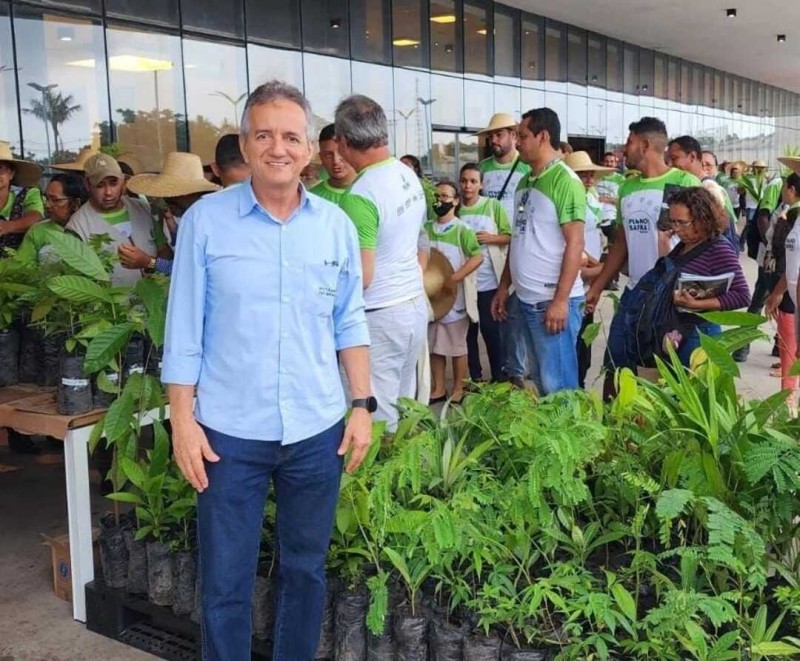
The handover took place on May 5th during the inauguration of the 2023-2024 Crop Plan at the Vasco Vasquez Convention Center. This initiative is set to uplift over 1,200 small-scale farmers in the Manaus Metropolitan Region and beyond, extending its reach to various municipalities within the Amazonas interior.
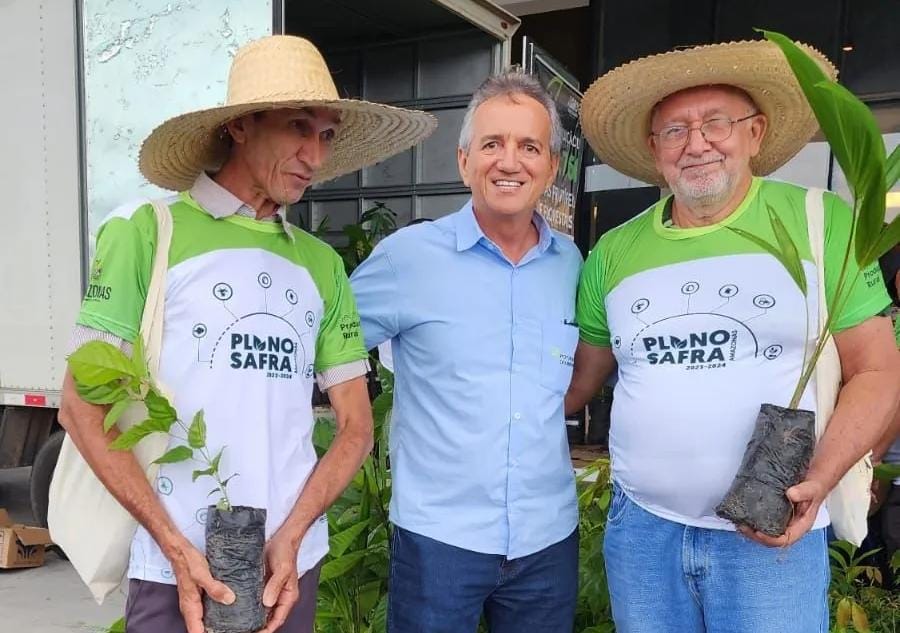
Representing Potássio do Brasil at the event, ESG director Lúcio Rabelo elaborated on the intent behind the donation. In line with the goals of the Autazes Potash Project, he highlighted the company’s commitment to bolster rural production, enhance food security, and mitigate climate change by sequestering greenhouse gases. Additionally, he emphasized on their strategy to safeguard water resources, rehabilitate degraded lands, and restore local biodiversity.
This move mirrors Potássio do Brasil’s commitment to align with the State Government’s efforts to confront the global climate crisis, reflecting its corporate ethos of contributing positively to the community.

Notably, the Urucurituba nursery, established in 2021, has already yielded over 42,000 seedlings representing 55 different agroforestry species. This substantial output underpins the company’s dedication to fostering a sustainable future, a key aspect of Brazil Potash’s mission and a cornerstone of the Autazes Potash Project.
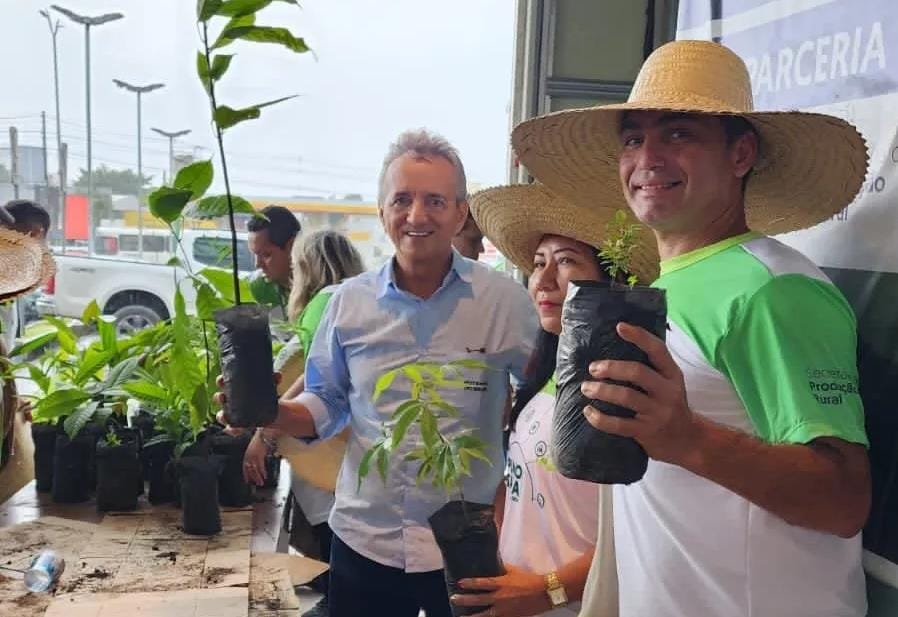
The above references an opinion and is for information purposes only. It is not intended to be investment advice. Seek a licensed professional for investment advice. The author is not an insider or shareholder of any of the companies mentioned above.
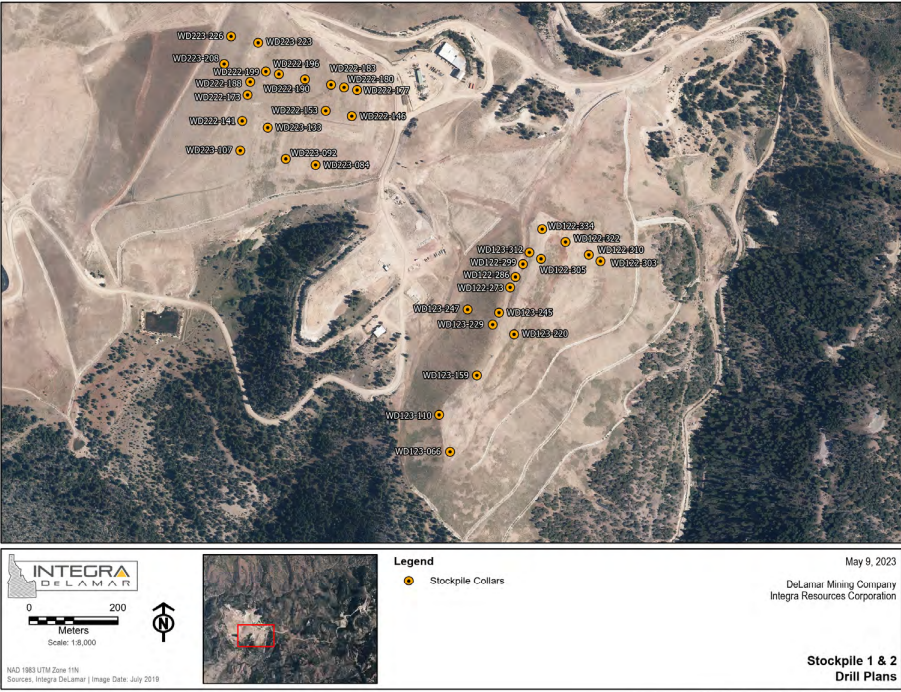
Integra Resources (TSXV:ITR) has released the results from 21 additional drill holes at the DeLamar Project in southwestern Idaho. These drill holes, encompassing 860 meters, form part of the stockpile drilling program recently concluded at the site. The company also provided updates on the anticipated share consolidation, set to come into effect on May 26, 2023, following receipt of final regulatory approvals.
Integra’s President, CEO & Director, Jason Kosec commented in a press release: “the successful completion of the stockpile drilling program this winter required a monumental effort and we are extremely thankful for our industry leading team at site. Overall, the drill program was a resounding success with the results exceeding our original estimates and modeling in terms of grade and continuity. The updated resource estimate, including results from the stockpile drill program is expected to demonstrate the potential for the material to significantly increase the heap leach mine life in future phases as well as enhance the overall project economics at DeLamar.”
The stockpile drilling initiative at DeLamar was conceived to investigate a significant part of the estimated 60 million tonnes of mineralized material stockpiled and used as backfill at the project site. The management is optimistic that the further oxide-and-mixed material from the stockpiles and backfill could extend the heap leach mine life of the project in future phases and strengthen the sturdy economic outlook proposed in the company’s 2022 Pre-feasibility Study.
Integra is resolutely concentrating on reaching several pivotal milestones in 2023. This includes an updated mineral resource estimate and the submission of the Mine Plan of Operations at DeLamar, along with a renewed mineral resource estimate and Preliminary Economic Study at the Wildcat & Mountain View Projects in western Nevada.
On the matter of share consolidation, following the court-approved arrangement facilitating the at-market merger of Integra and Millennial Precious Metals Corp. (“Millennial”) on May 4, 2023, the company plans to consolidate all of its common shares on the basis of one new post-consolidation common share for every 2.5 pre-consolidation common shares. The Board of Directors have given their approval to the consolidation, which will reduce the number of outstanding common shares from 171,943,828 to approximately 68,777,531. The consolidation will also bring about proportionate adjustments to the company’s outstanding stock options, restricted share units, and deferred share units, with no fractional common shares being issued.
A letter of transmittal regarding the consolidation will be sent to the company’s registered shareholders. They will be expected to send their pre-consolidation common shares, alongside a correctly executed letter of transmittal, to the company’s registrar and transfer agent, TSX Trust Company. Shareholders who hold their shares through a broker, investment dealer, bank, or trust company should get in touch with their respective nominee or intermediary for their post-consolidation positions. The post-consolidation common shares are expected to commence trading on the TSX Venture Exchange (the “TSXV”) and the NYSE American under its new CUSIP number 45826T509 (ISIN CA45826T5098) on May 26, 2023. The company’s TSXV ticker symbol “ITR” and NYSE American ticker symbol “ITRG” will remain unchanged.
Concerning Millennial Warrants, each Millennial warrant will entitle the holder to receive the same aggregate consideration upon exercise, in lieu of the number of Millennial common shares that such holder was previously entitled to upon exercise of such Millennial Warrants. The terms governing the warrants will remain the same as those in effect prior to the effective time of the Arrangement and will be governed by the terms of the applicable warrant instruments. Proportionate adjustments will be made to the aggregate number of common shares that such holder is entitled to upon exercise of such Millennial Warrants and to the exercise price of the Millennial Warrants.
Before the completion of the Arrangement, Millennial had an outstanding class of Millennial Warrants listed on the TSXV under the trading symbol MPM.WT. These will continue trading on the TSXV as Millennial Warrants, under their existing trading symbol, until their exercise, expiry, or delisting. The exercise price of the Listed Millennial Warrants will see an adjustment from CDN$0.55 to CDN$1.375, with each Listed Millennial Warrant being exercisable to acquire 0.092 of a Common Share.
As mandated by the warrant indenture for the Listed Millennial Warrants, Integra has entered into a supplemental warrant indenture to govern the Listed Millennial Warrants.
Highlights from the drill results are as follows:
- The stockpile drilling program at DeLamar was completed in April 2023 and consisted of 321 holes, totalling 12,588 m.
- The latest drill results from DeLamar (North DeLamar, Sommercamp, Stockpile 1 and 2) include:
- NDM-23-118: 0.38 grams per tonne (“g/t”) gold (“Au”) and 22.52 g/t silver (“Ag”) (0.67 g/t gold equivalent (“AuEq”)) over 80.77 m
- WD1-23-299: 0.31 g/t Au and 20.63 g/t Ag (0.58 g/t AuEq) over 48.77 m
- NDM-23-199: 0.29 g/t Au and 14.34 g/t Ag (0.48 g/t AuEq) over 85.34 m
- NDM-23-021: 0.21 g/t Au and 22.61 g/t Ag (0.50 g/t AuEq) over 54.87 m
- NDM-23-053: 0.26 g/t Au and 20.91 g/t Ag (0.53 g/t AuEq) over 50.29 m
- The latest drill results from Florida Mountain (Jacobs Gulch and Tip Top) include:
- JG-23-027: 0.38 g/t Au and 11.85 g/t Ag (0.53 g/t AuEq) over 27.43 m
- JG-23-075: 0.34 g/t Au and 15.25 g/t Ag (0.54 g/t AuEq) over 21.34 m
- JG-23-100: 0.33 g/t Au and 6.04 g/t Ag (0.40 g/t AuEq) over 70.10 m
- Observations are consistent with previously reported results from the stockpile drilling program, with results demonstrating excellent gold equivalent grade and drill intercept widths with strong continuity throughout the material.
- Final drill samples have been shipped to the assay lab and estimation work has commenced for the updated mineral resource estimate at DeLamar, including results from the stockpile drilling program.
- Results from 8,229 m, representing 226 drill holes, have yet to be released. The Company will continue to release results as they are received from the lab.
Detailed Drill Results
The following table highlights selected intercepts from the DeLamar backfill and stockpile drill program announced today1,2,3,4:
| Drill Hole | From (m) | To (m) | Interval (m) | g/t Au | g/t Ag | g/t AuEq | AuCN Recovery (%) |
| NDM-23-021 | 1.52 | 56.39 | 54.87 | 0.21 | 22.61 | 0.50 | 73.72 |
| NDM-23-053 | 0.00 | 50.29 | 50.29 | 0.26 | 20.91 | 0.53 | 71.13 |
| NDM-23-118 | 0.00 | 80.77 | 80.77 | 0.38 | 22.52 | 0.67 | 58.22 |
| NDM-23-199 | 0.00 | 85.34 | 85.34 | 0.29 | 14.34 | 0.48 | 71.60 |
| SC-23-024 | 0.00 | 13.72 | 13.72 | 0.27 | 20.84 | 0.54 | 58.61 |
| SC-23-032 | 1.52 | 28.96 | 27.44 | 0.25 | 18.05 | 0.48 | 67.68 |
| SC-23-034 | 0.00 | 15.24 | 15.24 | 0.24 | 26.34 | 0.57 | 74.72 |
| SC-23-119 | 1.52 | 9.14 | 7.62 | 0.30 | 39.79 | 0.81 | 84.07 |
| WD1-23-066 | 0.00 | 41.15 | 41.15 | 0.13 | 21.32 | 0.40 | 46.77 |
| WD1-23-220 | 0.00 | 50.29 | 50.29 | 0.18 | 13.18 | 0.35 | 74.39 |
| WD1-23-229 | 0.00 | 48.77 | 48.77 | 0.31 | 20.63 | 0.58 | 72.47 |
| WD1-23-247 | 0.00 | 16.76 | 16.76 | 0.21 | 34.98 | 0.66 | 89.30 |
| WD2-23-107 | 0.00 | 21.34 | 21.34 | 0.39 | 14.60 | 0.58 | 80.51 |
| WD2-23-133 | 0.00 | 44.20 | 44.20 | 0.17 | 14.36 | 0.35 | 75.83 |
| WD2-23-208 | 1.52 | 41.15 | 39.63 | 0.26 | 9.76 | 0.39 | 70.13 |
| WD2-23-226 | 1.52 | 30.48 | 28.96 | 0.18 | 18.27 | 0.41 | 78.05 |
(1) Downhole thickness is true thickness.
(2) Intervals reported are uncapped.
(3) AuEq = g/t Au + (g/t Ag ÷ 77.70). Rounding may cause minor discrepancies in the AuEq column.
(4) Au recovery based on cyanide shakes (“AuCN”) run on all intervals with Au assay values >0.1 g/t.
The following table highlights selected intercepts from the Florida Mountain stockpile and backfill drill program announced today1,2,3:
| Drill Hole | From (m) | To (m) | Interval (m) | g/t Au | g/t Ag | g/t AuEq |
| JG-23-027 | 0.00 | 27.43 | 27.43 | 0.38 | 11.85 | 0.53 |
| JG-23-075 | 0.00 | 21.34 | 21.34 | 0.34 | 15.25 | 0.54 |
| JG-23-100 | 0.00 | 70.10 | 70.10 | 0.33 | 6.04 | 0.40 |
| JG-23-106 | 0.00 | 48.77 | 48.77 | 0.33 | 6.38 | 0.41 |
| TT-23-036 | 0.00 | 21.34 | 21.34 | 0.34 | 10.37 | 0.47 |
(1) Downhole thickness is true thickness.
(2) Intervals reported are uncapped.
(3) AuEq = g/t Au + (g/t Ag ÷ 77.70). Rounding may cause minor discrepancies in the AuEq column.
Cyanide shake analysis is not performed on Florida Mountain samples as gold occurrences in Florida Mountain material can often be coarse in nature, making comparisons between cyanide shake analyses and fire assays unreliable. Once pulverized, as per any cyanide shake procedure, all Florida Mountain material show high recoveries by cyanidation, rendering cyanide shake analysis unreliable for differentiating between ores that can be heap leached and those requiring grinding to achieve high recoveries.
The above references an opinion and is for information purposes only. It is not intended to be investment advice. Seek a licensed professional for investment advice. The author is not an insider or shareholder of any of the companies mentioned above.

Marimaca Copper (TSX:MARI) has shared a revised Mineral Resource Estimate (MRE) for its flagship Marimaca Oxide Deposit (MOD) project located in the Antofagasta region of northern Chile.
The updated 2023 MRE integrates a substantial 28,374m of fresh drilling data that was collated subsequent to the unveiling of the 2022 MRE in October 2022. Since the MOD’s inception in 2016, a cumulative total of 139,164m of drilling has been completed. The recent drilling data, gathered following the release of the 2022 MRE, mainly focused on enhancing the conversion of Inferred Resources into the Measured and Indicated categories.
The updated MRE adheres strictly to the Definition Standards set by the Canadian Institute of Mining, Metallurgy and Petroleum (CIM) and the National Instrument 43-101 – Standards of Disclosure for Mineral Projects (NI 43-101).
The significant highlights from the MRE include:
- Measured and Indicated Resources totalling 200.3Mt at 0.45% CuT, encapsulating 900kt of contained copper
- Inferred Resources measuring 37.3Mt at 0.38% CuT, encompassing 141kt of contained copper
- A robust 86% of the total resource tonnes of the MOD now fall under the Measured and Indicated categories
- The updated MRE significantly lowers the risk associated with the Marimaca ore body in anticipation of the forthcoming Definitive Feasibility Study (DFS)
- The majority of the recent drilling operations were concentrated in the northern parts of the MOD, which had earlier been associated with lower drilling density
The MOD continues to demonstrate unique characteristics in the 2023 MRE, such as a low strip ratio maintained in the constraining pit shell and all mineral resources captured within a single continuous pit. It marks the final phase of oxide resource definition at the MOD before the planned DFS. The company’s exploration focus will now shift towards the Marimaca sulphide target and the definition of near-mine satellite oxide targets, including Mercedes, Cindy, and Mititus.
The 2023 MRE was compiled by independent consultants NCL Ingeniería y Construcción SpA (NCL) and authenticated by Luis Oviedo, a qualified person independent of Marimaca, as per the terms under NI 43-101. The updated MRE reflects 139,164m of drilling across 554 drill holes completed between 2016 and 2022, with an effective date of May 17, 2023. The same operating cost parameters as the 2022 MRE were used for the Whittle Optimisations, alongside a copper price assumption of US$4.00/lb.
Marimaca has also concluded five extensive phases of metallurgical testing at Marimaca. A sixth phase is currently in progress, which is expected to define the optimized process design flowsheet before the planned DFS. The results from the fifth phase, announced on June 15, 2022, indicate a promising larger proportion of total copper is expected to be recovered in industrial-scale operations.

The Marimaca Deposit showcases the continuity of the oxide mineralization across the north-south extent of the deposit, with the mineralization consistently hosted by east-dipping fracture sets. Higher grade zones of oxides, mixed and enriched mineralization, extend at depth beneath the green oxide zones.
Exploration for sulphide mineralization down-dip of the MOD to the east is ongoing, and further results will be made public in the coming months.
Hayden Locke, President & CEO of Marimaca Copper, commented in a press release: “The 2023 MRE represents the culmination of an exceptionally successful two years of infill drilling at the Marimaca Oxide Deposit led by Sergio Rivera and his team. We are very pleased with our conversion ratio of Inferred Resources to Measured and Indicated categories, and today’s result drives significantly improved confidence in the geological model and understanding of the Marimaca ore body.
“The M&I resource estimate at the MOD now stands at approximately 900,000 tonnes of contained metal, and this will support the assessment of a larger operation in terms of copper cathode production and mine life extension during the Definitive Feasibility Study. Despite the significant resource growth demonstrated at Marimaca since 2019, the ore body’s core, unique attributes have been preserved as the deposit has grown – very low strip ratio; a shallow higher-grade core expected to be accessible in the early mining years; and limited pre-stripping or significant cutbacks expected during operation.
“We continue to progress rapidly forward with development workstreams at the MOD including preparation for our permitting submissions and the Feasibility Study. Additionally, the first phase of the 2023 sulphide exploration program has been completed with assays pending and results expected in the near term.”
Results from the updated MRE are as follows:

| Mineral Resource Category and Type | Quantity | CuT | CuS | CuT | CuS |
| (kt) | (%) | (%) | (t) | (t) | |
| Total Measured | 96,954 | 0.49 | 0.28 | 473,912 | 268,628 |
| Total Indicated | 103,358 | 0.41 | 0.21 | 425,797 | 219,690 |
| Total Measured and Indicated | 200,312 | 0.45 | 0.24 | 899,709 | 488,319 |
| Total Inferred | 37,289 | 0.38 | 0.15 | 141,252 | 55,802 |
Table 1. 2023 Mineral Resource Estimate (reported at 0.15% CuT cutoff)
* Pit shell constrained resources with demonstrated reasonable prospects for eventual economic extraction (RPEEE) are generated using series of Lerchs-Grossmann pit shell optimizations completed by NCL
* CuT means total copper and CuS means acid soluble copper. Technical and economic parameters include: copper price US$4.00/lb; base mining cost of US$1.51/t with a mining cost adjustment factor of US$0.04/t-10m bench; Heap Leach “HL” processing cost US$5.94/t (incl. G&A); Run-of-Mine “ROM” processing cost US$1.65/t (incl. G&A); SX-EW processing cost and selling cost US$0.16/lb Cu; heap leach recovery 76% of CuT; ROM recovery 40% of CuT; and 42°-52° pit slope angle
* Mineral resources which are not mineral reserves do not have demonstrated economic viability. Due to the uncertainty which may attach to inferred mineral resources, it cannot be assumed that all or any part of an inferred mineral resource will be upgraded to an indicated or measured mineral resource as a result of continued exploration
| Cut-off grade (% CuT) |
Measured | Indicated | Measured + Indicated | Inferred | |||||||||
| Quantity kt | CuT [%] | CuS [%] | Quantity kt | CuT [%] | CuS [%] | Quantity kt | CuT [%] | CuS [%] | Quantity kt | CuT [%] | CuS [%] | ||
| 0.40 | 44.0 | 0.77 | 0.44 | 37.5 | 0.69 | 0.38 | 81.6 | 0.73 | 0.41 | 12.1 | 0.64 | 0.24 | |
| 0.30 | 60.2 | 0.65 | 0.38 | 55.5 | 0.58 | 0.31 | 115.7 | 0.62 | 0.35 | 18.8 | 0.54 | 0.21 | |
| 0.22 | 77.8 | 0.56 | 0.32 | 77.0 | 0.49 | 0.26 | 154.9 | 0.53 | 0.29 | 27.2 | 0.45 | 0.18 | |
| 0.20 | 83.0 | 0.54 | 0.31 | 83.8 | 0.47 | 0.25 | 166.8 | 0.50 | 0.28 | 30.2 | 0.43 | 0.17 | |
| 0.18 | 88.3 | 0.52 | 0.30 | 91.3 | 0.44 | 0.23 | 179.6 | 0.48 | 0.26 | 33.0 | 0.41 | 0.16 | |
| 0.15 | 97.0 | 0.49 | 0.28 | 103.4 | 0.41 | 0.21 | 200.3 | 0.45 | 0.24 | 37.3 | 0.38 | 0.15 | |
| 0.10 | 113.3 | 0.44 | 0.24 | 127.6 | 0.36 | 0.18 | 241.0 | 0.39 | 0.21 | 46.6 | 0.33 | 0.13 | |
| 0.00 | 146.1 | 0.35 | 0.19 | 178.2 | 0.27 | 0.14 | 324.3 | 0.31 | 0.16 | 72.0 | 0.24 | 0.09 | |
Table 2. Mineral Resource Sensitivity
* Pit shell constrained resources with demonstrated reasonable prospects for eventual economic extraction (RPEEE) are generated using series of Lerchs-Grossmann pit shell optimizations completed by NCL
* CuT means total copper and CuS means acid soluble copper. Technical and economic parameters include: copper price US$4.00/lb; base mining cost of US$1.51/t with a mining cost adjustment factor of US$0.04/t-10m bench; Heap Leach “HL” processing cost US$5.94/t (incl. G&A); Run-of-Mine “ROM” processing cost US$1.65/t (incl. G&A); SX-EW processing cost and selling cost US$0.16/lb Cu; heap leach recovery 76% of CuT; ROM recovery 40% of CuT; and 42°-52° pit slope angle
* Mineral resources which are not mineral reserves do not have demonstrated economic viability. Due to the uncertainty which may attach to inferred mineral resources, it cannot be assumed that all or any part of an inferred mineral resource will be upgraded to an indicated or measured mineral resource as a result of continued exploration
| Mineral Resource Category and Type | Quantity | CuT | CuS | CuT | CuS |
| (kt) | (%) | (%) | (t) | (t) | |
| Measured | |||||
| Brochantite | 31,293 | 0.62 | 0.45 | 194,890 | 141,442 |
| Chrysocolla | 24,252 | 0.44 | 0.33 | 105,594 | 79,863 |
| Wad/Black oxides | 10,727 | 0.29 | 0.15 | 30,599 | 16,116 |
| Mixed | 18,626 | 0.51 | 0.13 | 95,159 | 23,431 |
| Enriched | 12,056 | 0.40 | 0.06 | 47,669 | 7,776 |
| Total Measured | 96,954 | 0.49 | 0.28 | 473,912 | 268,628 |
| Indicated | |||||
| Brochantite | 29,084 | 0.56 | 0.41 | 162,753 | 117,847 |
| Chrysocolla | 13,591 | 0.38 | 0.28 | 51,332 | 37,674 |
| Wad/Black oxides | 19,880 | 0.28 | 0.15 | 56,382 | 29,649 |
| Mixed | 17,193 | 0.41 | 0.11 | 71,109 | 18,654 |
| Enriched | 23,611 | 0.36 | 0.07 | 84,221 | 15,867 |
| Total Indicated | 103,358 | 0.41 | 0.21 | 425,797 | 219,690 |
| Measured and Indicated | |||||
| Brochantite | 60,376 | 0.59 | 0.43 | 357,643 | 259,290 |
| Chrysocolla | 37,843 | 0.41 | 0.31 | 156,927 | 117,536 |
| Wad/Black oxides | 30,607 | 0.28 | 0.15 | 86,981 | 45,765 |
| Mixed | 35,819 | 0.46 | 0.12 | 166,268 | 42,085 |
| Enriched | 35,667 | 0.37 | 0.07 | 131,891 | 23,643 |
| Total Measured and Indicated | 200,312 | 0.45 | 0.24 | 899,709 | 488,319 |
| Inferred | |||||
| Brochantite | 4,950 | 0.46 | 0.32 | 22,892 | 15,710 |
| Chrysocolla | 4,488 | 0.36 | 0.26 | 16,250 | 11,695 |
| Wad/Black oxides | 8,727 | 0.29 | 0.15 | 25,180 | 12,799 |
| Mixed | 5,979 | 0.36 | 0.11 | 21,548 | 6,541 |
| Enriched | 13,145 | 0.42 | 0.07 | 55,381 | 9,057 |
| Total Inferred | 37,289 | 0.38 | 0.15 | 141,252 | 55,802 |
Table 3. 2023 MRE by Mineralization Type
* Pit shell constrained resources with demonstrated reasonable prospects for eventual economic extraction (RPEEE) are generated using series of Lerchs-Grossmann pit shell optimizations completed by NCL
* CuT means total copper and CuS means acid soluble copper. Technical and economic parameters include: copper price US$4.00/lb; base mining cost of US$1.51/t with a mining cost adjustment factor of US$0.04/t-10m bench; Heap Leach “HL” processing cost US$5.94/t (incl. G&A); Run-of-Mine “ROM” processing cost US$1.65/t (incl. G&A); SX-EW processing cost and selling cost US$0.16/lb Cu; heap leach recovery 76% of CuT; ROM recovery 40% of CuT; and 42°-52° pit slope angle
* Mineral resources which are not mineral reserves do not have demonstrated economic viability. Due to the uncertainty which may attach to inferred mineral resources, it cannot be assumed that all or any part of an inferred mineral resource will be upgraded to an indicated or measured mineral resource as a result of continued exploration
| Parameter | 2022 MRE | 2023 MRE |
| Mining cost (US$/t mined) | $1.51 base ($1.76 avg.) | $1.51 base ($1.76 avg.) |
| Mining Cost Adjustment Factor (US$/t-10m bench) | $0.04 | $0.04 |
| Heap Leach Cost (including G&A and mining cost component from pit to Heap Leach) | US$5.94/t processed | US$5.94/t processed |
| Run-of-Mine Cost (including G&A and mining cost component from pit to ROM) | US$1.65/t processed | US$1.65/t processed |
| SX-EW processing cost and selling cost (US$/lb Cu) | $0.16 | $0.16 |
| Heap Leach Recovery (% CuT) | 76% | 76% |
| ROM Recovery (% CuT) | 40% | 40% |
| Pit Slope angle | 42 – 52° | 42 – 52° |
Table 4. Summary of Inputs – 2023 MRE (no changes from 2022 MRE)
The Company intends to file an updated technical report to support the updated 2023 MRE on SEDAR within 45 days of this news release or such earlier time in accordance with NI 43-101.
The above references an opinion and is for information purposes only. It is not intended to be investment advice. Seek a licensed professional for investment advice. The author is not an insider or shareholder of any of the companies mentioned above.
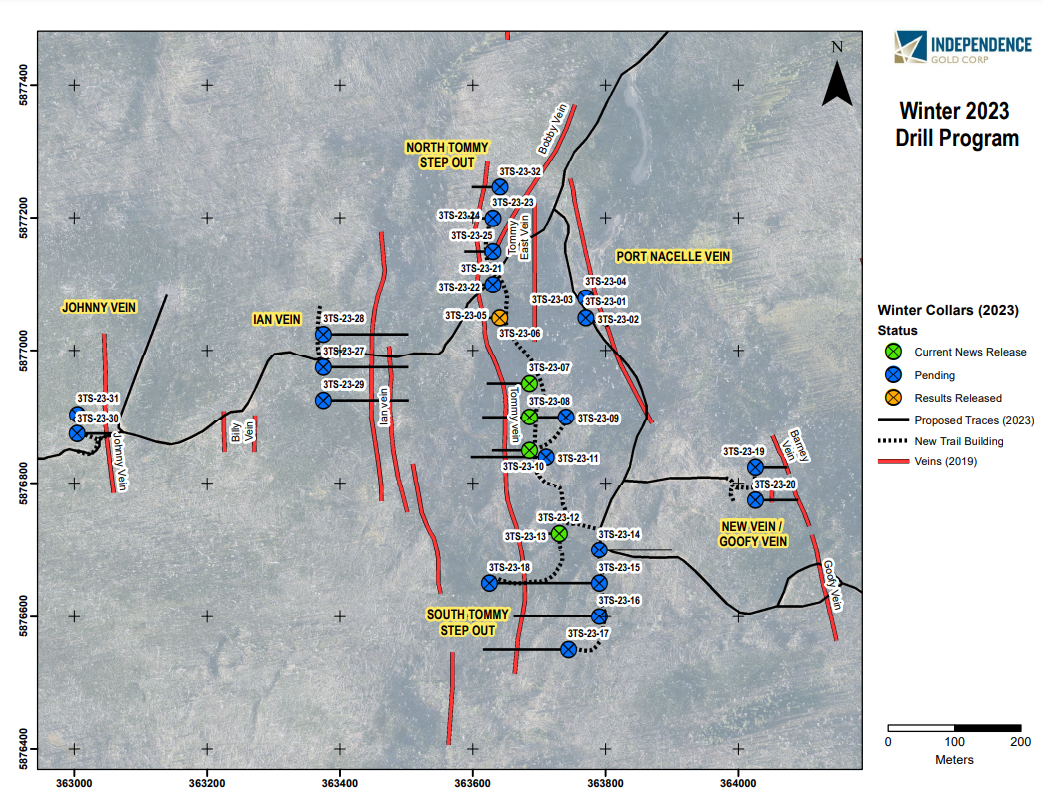
Independence Gold (TSXV:IGO) has announced the latest findings from its winter drill program, which spanned 4,000 meters at the 3Ts Project. The project, wholly owned by Independence Gold Corp., is located around 185 kilometres southwest of Prince George, British Columbia. Notably, it sits just 16 kilometres southwest of Artemis Gold Inc.’s Blackwater Project.
The primary objective of the winter drill program was to explore targets beyond the known Tommy vein system and to fill in significant gaps in historical drilling of the Tommy vein system, as highlighted in the 2022 resource model. The Tommy and Ted-Mint vein systems, comprising both in-pit and underground components, contain a combined inferred resource estimate of 4,469,297 tonnes. These veins have a grading of 3.64 grams per tonne (“g/t”) gold and 96.26 g/t silver, with 522,330 ounces of gold and 13,831,415 ounces of silver, subject to a cut-off grade of 0.4 g/t gold equivalent (“AuEq”) in-pit and 2.0 g/t AuEq underground. (For detailed information, please refer to the news release dated August 18th, 2022.)
The drill holes with designations 3TS-23-07, 3TS-23-08, and 3TS-23-10 specifically targeted the central section of the Tommy vein, which is known to have a strike length of 1,075 meters. These holes were positioned within the pit shell modelled by SGS Geological Services (“SGS”), with the aim of expanding the resource model. Thirteen drill holes were strategically selected to target the pit in the current program, aiming to enhance the resource model. The aforementioned three holes were spaced 50 meters apart along a north-south line. In addition, drill hole 3TS-23-13 was located 130 meters south-southeast from 3TS-23-10, examining the continuity of the southern extension of the vein. It is worth noting that the Tommy vein system remains open along its strike length and at depth.
In addition to the Tommy vein, the drill program focused on the Ian Vein and the Johnny veins. These veins were initially discovered through historical trenching in the late 1990s and are positioned 185 meters and 585 meters west of the Tommy vein system, respectively. Three holes were directed towards the Ian Vein, while two holes were drilled in the Johnny Vein. Preliminary results indicate the presence of significant quartz veining, with intercepts measuring up to 27 meters. Further analysis is pending for all five holes, with completion expected in the following weeks. Both the Ian and Johnny veins also remain open along their strike lengths and at depth. For a visual representation of the veins and drill hole locations, interested parties can refer to the company’s website.
Providing an update on the ongoing drill program, Independence Gold Corp. stated that it began on March 7th, 2023, and is set to conclude in the last week of May. Throughout the program, a total of 4,000 meters of drill core has been recovered from 33 drill holes. As the lab processes the results, they are being released in a non-sequential order due to varying submission dates following logging and sample preparation.
All completed drill holes have been sent to SGS in Vancouver for sample preparation and analysis. To ensure reproducibility, robotic sample preparation is employed, with samples pulverized to more than 85% passing 75 microns. Subsequently, all samples undergo four acid digest with an ICP finish. Fire assay with AAS finish is utilized to determine gold grades. Samples showing gold concentration exceeding 10 parts per million and silver concentrations exceeding 100 parts per million undergo a fire assay with a gravimetric finish.
The 3Ts Project encompasses fifteen mineral claims, covering an area of approximately 5,200 hectares in British Columbia’s Nechako Plateau region. Within the project, an epithermal quartz-carbonate vein system has been identified, housing over a dozen individual mineralized veins. These veins range in width from 50 meters to over 900 meters, with true widths reaching up to 25 meters.
| Drill Hole | Host Rock | From (m) | To (m) | Drill Intercept (m)* |
Gold (g/t) |
Silver (g/t) |
| 3TS-23-07 | Quartz Veins, Rhyolite Breccia |
62.50 | 72.50 | 10.00 | 4.69 | 73.70 |
| including | 70.00 | 72.00 | 2.00 | 11.34 | 94.00 | |
| 3TS-23-08 | Quartz Veins, Rhyolite Breccia |
59.90 | 62.90 | 3.00 | 6.35 | 39.33 |
| and | 70.00 | 71.00 | 1.00 | 1.53 | – | |
| 3TS-23-10 | Quartz Veins, Rhyolite Breccia |
56.00 | 71.00 | 15.00 | 6.32 | 94.07 |
| Including | 67.50 | 69.00 | 1.50 | 26.36 | 274.67 | |
| 3TS-23-13 | Quartz Veins, Rhyolite Breccia |
128.50 | 140.00 | 11.50 | 7.72 | 172.85 |
| including | 134.50 | 137.50 | 3.00 | 16.63 | 232.00 |
*the true widths of the veins are approximately 85% of the reported interval width
**Using a cut-off grade of 0.4 g/t gold as per the resource estimate for “in-pit” grades
The above references an opinion and is for information purposes only. It is not intended to be investment advice. Seek a licensed professional for investment advice. The author is not an insider or shareholder of any of the companies mentioned above.
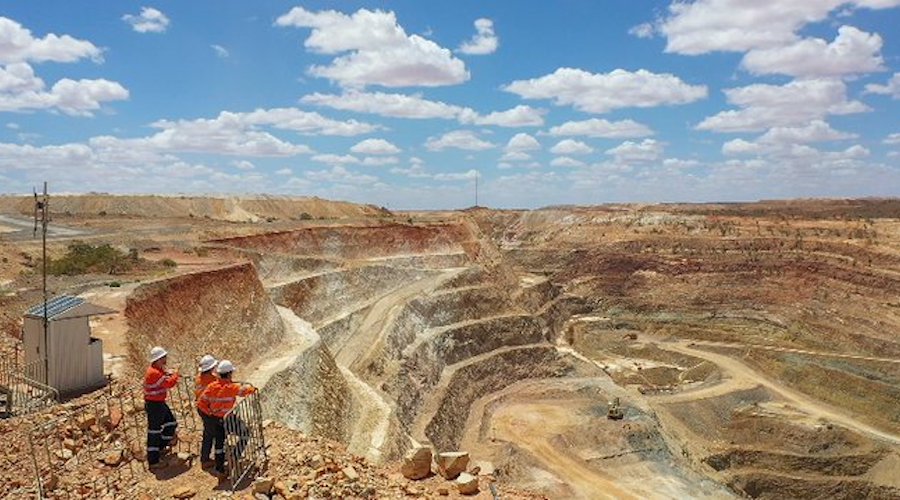
In a major announcement, Newcrest Mining (ASX:NCM) confirmed it has approved a monumental takeover offer from Newmont (NYSE:NEM), a deal estimated to be worth A$28.8 billion ($19.2 billion). This colossal business merger is expected to create the world’s premier gold mining enterprise.
The deal is structured such that Newcrest shareholders will acquire 0.4 shares of Newmont for each Newcrest share they hold. This arrangement allows them to secure 31% ownership in the resultant merged entity, a fact affirmed by the Melbourne-based firm, following a Bloomberg News report from Sunday.
The agreement culminates in an inferred enterprise value for Newcrest of A$28.8 billion, incorporating the net debt. Furthermore, Newcrest is committed to disbursing a franked special pre-completion dividend, reaching up to $1.10 per share. Preceding this agreement, Newcrest had consented to extend Newmont’s due-diligence rights to May 18, post the expiry of an earlier deadline.
Newcrest’s chairman, Peter Tomsett, lauded the transaction, stating, “This transaction will combine two of the world’s leading gold producers, bringing forward significant value to Newcrest shareholders through the recognition of our outstanding growth pipeline.”
The expanded Newmont will possess gold assets spread across the globe from North and South America to Africa, Australia, and Papua New Guinea. The merger also signifies an expanded interest in copper, a critical metal in the clean energy transition.
This transaction could potentially represent the zenith of a rapid five-year consolidation amongst the world’s top gold miners, a trend that took off with Barrick Gold Corp’s $18 billion acquisition of Randgold Resources Ltd. and includes the recent $5.2 billion takeover of Yamana Gold Inc. in March. The announcement of Newmont’s proposal coincides with a time when the spot trading price of bullion is nearing a historic peak, amidst global stagflation concerns.
Newmont initially proposed a $17 billion non-binding bid to its Australian counterpart in February, which was turned down by Newcrest’s board. In April, the US company increased the offer to $19.5 billion, terming it as the best and final offer. Sherry Duhe, Newcrest’s chief executive officer, has stated that the board was ready to endorse the proposal to its shareholders, contingent upon successful due diligence.
The global gold mining industry is grappling with the prospects of stagnant production, increasingly challenging mining deposits, and escalating input costs. These industry hurdles are thought to be a driving force for more mergers and acquisitions, as firms strive for expansion to escalate production and gain efficiencies through economies of scale.
Newcrest’s allure for Newmont extends beyond its five gold mines spanning three continents, as the Australian company generates approximately one-fourth of its revenue from copper. Newmont, currently facing a decade-long slump in gold, has expressed a desire to diversify, aiming for more of the energy-transition metal in its portfolio.
The above references an opinion and is for information purposes only. It is not intended to be investment advice. Seek a licensed professional for investment advice. The author is not an insider or shareholder of any of the companies mentioned above.

Faraday Copper (TSX:FDY), a Canadian copper exploration company, announced today the latest results from a series of drill holes at its flagship Copper Creek Project, situated in Arizona, U.S. The findings suggest promising mineralization, reinforcing the project’s potential for robust copper production and hinting at significant gold presence.
The company’s report highlighted a 45.89-meter intersection at the Childs Aldwinkle breccia complex, boasting 1.68% copper, 0.33 g/t gold, 5.55 g/t silver, and 0.028% molybdenum, starting from 184.72 meters in drill hole FCD-22-023. This notable find suggests considerable gold prospects that were not factored into the Mineral Resource Estimate (MRE) earlier this month.
Paul Harbidge, President and CEO, commented in a press release: “The continued success of our Phase II drill program confirms our view that there is significant upside to the open pit and underground resource utilized as the basis for the PEA. In particular, drill hole FCD-23-023 returned high copper grades and enrichment in gold. This highlights the potential to add gold credits to the current resource through both future drilling and our ongoing assaying of historical core and pulps that were not analyzed in the past. We look forward to providing updates as we progress.”
Drill hole FCD-23-025 revealed further interesting data, intersecting 136.48 meters with 0.54% copper and 0.83 g/t silver from 278.61 meters. The findings also include a significant 66.26 meters with 0.87% copper and 1.22 g/t silver, and a noteworthy 309.43 meters at 0.31% copper and 0.83 g/t silver. This significant intersection testifies to the mineralization between the Keel and American Eagle underground zones, indicating that there’s still much to discover.
Alongside these findings, Faraday Copper has embarked on a gold assaying program. This initiative aims to analyze historical drill core to gauge its potential for inclusion in future resource updates, as well as for metallurgical testing purposes.
Drill hole FCD-22-023, set southwest of Childs Aldwinkle, exhibited potential for substantial gold mineralization within the high-grade copper mineralization of the open pit resource. Further, drill hole FCD-23-025, initiated west of Mammoth, confirmed the potential for continuous mineralization between two underground footprints, suggesting the need for additional exploration.
Two more holes, FCD-23-021 and FCD-23-022, targeted the yet unexplored Hilltop breccia, east of Copper Prince. Both intersected near-surface mineralization above the cut-off grade for the open pit mineral resource, indicating potential for further exploration.
Finally, reconnaissance drill holes FCD-22-019 and FCD-22-020 probed the Gin breccia, north of the mineral resource area. Both intersected over 100 meters of pyrite cemented breccia, revealing anomalous silver and suggesting potential copper mineralization below the current drilling depth.
As the Phase II drilling is underway, Faraday Copper is preparing to launch a series of geological mapping, rock sampling, and geophysical data collection to guide future drill campaigns, scheduled for the fourth quarter of 2023.
Faraday Copper Corp., with a strong focus on its principal copper project in the U.S., is committed to exploring the full potential of Copper Creek, one of North America’s largest undeveloped copper projects. The company is well-capitalized to meet its key milestones and benefits from a seasoned management team and board of directors with substantial mining company experience and expertise.
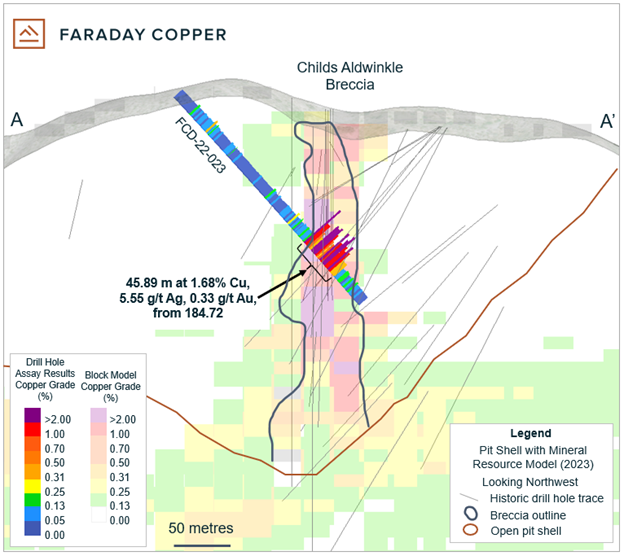
Highlights from the results are as follows:
- Intersected 45.89 metres (“m”) at 1.68% copper, 0.33 g/t gold, 5.55 g/t silver and 0.028% molybdenum from 184.72 m at the Childs Aldwinkle breccia complexin drill hole FCD-22-023 (Figures 1 and 2). This hole highlights the potential gold upside on the property, which was not included in the Mineral Resource Estimate (“MRE”) (see news release dated May 3, 2023).
- Intersected 136.48 m at 0.54% copper and 0.83 g/t silver from 278.61 m, including 66.26 m at 0.87% copper and 1.22 g/t silver from 278.61 m, and 309.43 m at 0.31% copper and 0.83 g/t silver from 693.16 m in drillhole FCD-23-025 (Figures 1 and 3). The upper intersection from 278.61 m corresponds to the Mammoth breccia whereas the lower portion of the hole was aimed at testing the gap between the Keel and American Eagle underground footprints. The hole confirms mineralization in this gap, where drill density remains limited.
- Commenced a gold assaying program of historical drill core to determine the potential for inclusion in future resource updates. Samples will also be taken for metallurgical test work.
Table 1: Selected Drill Results from Copper Creek
| Drill Hole ID | From | To | Length | True width | Cu | Mo | Au | Ag |
| (m) | (m) | (m) | (m) | (%) | (%) | (g/t) | (g/t) | |
| FCD-23-023 | 184.72 | 230.61 | 45.89 | 35 | 1.68 | 0.028 | 0.33 | 5.55 |
| FCD-23-025 | 278.61 | 415.09 | 136.48 | 88 | 0.54 | 0.001 | <0.01 | 0.83 |
| including | 278.61 | 344.87 | 66.26 | 43 | 0.87 | 0.001 | <0.01 | 1.22 |
| and | 462.47 | 506.08 | 43.61 | 43 | 0.20 | 0.001 | <0.01 | 0.55 |
| and | 693.16 | 1,002.59 | 309.43 | 309 | 0.31 | 0.003 | 0.02 | 0.83 |
| FCD-23-021 | 6.00 | 44.86 | 38.86 | 38 | 0.18 | <0.001 | N/A | 0.54 |
| FCD-23-022 | 8.89 | 69.24 | 60.35 | 60 | 0.16 | <0.001 | N/A | 0.18 |
| FCD-22-019 | No significant intercepts | |||||||
| FCD-22-020 | No significant intercepts | |||||||
Notes: All intercepts are reported as downhole drill widths. True widths are approximate due to the inherently irregular shape of mineralized domains. Gold values reported as <0.01 g/t indicate concentrations of less than 10 times the analytical limit of detection (0.001 g/t). Molybdemun values of less than 10 parts per million are listed as < 0.001%.
Table 2: Collar Locations from the Drill Holes Reported Herein
| Drill Hole ID | Easting | Northing | Elevation | Azimuth | Dip | Target | Depth | Depth |
| (m) | (°) | (°) | (ft) | (m) | ||||
| FCD-23-023 | 548345 | 3623971 | 1,306 | 045 | -47 | Childs Aldwinkle | 813.8 | 267.00 |
| FCD-23-025 | 548225 | 3623757 | 1,181 | 110 | -60 | American Eagle | 3,195.9 | 1,048.51 |
| FCD-23-021 | 548429 | 3624688 | 1,349 | 230 | -45 | Hilltop | 457.3 | 150.04 |
| FCD-23-022 | 548429 | 3624689 | 1,349 | 278 | -45 | Hilltop | 384.8 | 126.25 |
| FCD-22-019 | 547071 | 3625879 | 1,387 | 200 | -53 | Gin | 610.9 | 200.44 |
| FCD-22-020 | 547070 | 3625880 | 1,387 | 245 | -50 | Gin | 761.8 | 249.94 |
Note: Coordinates are given as World Geodetic System 84, Universal Transverse Mercator Zone 12 north (WGS84, UTM12N).
The above references an opinion and is for information purposes only. It is not intended to be investment advice. Seek a licensed professional for investment advice. The author is not an insider or shareholder of any of the companies mentioned above.
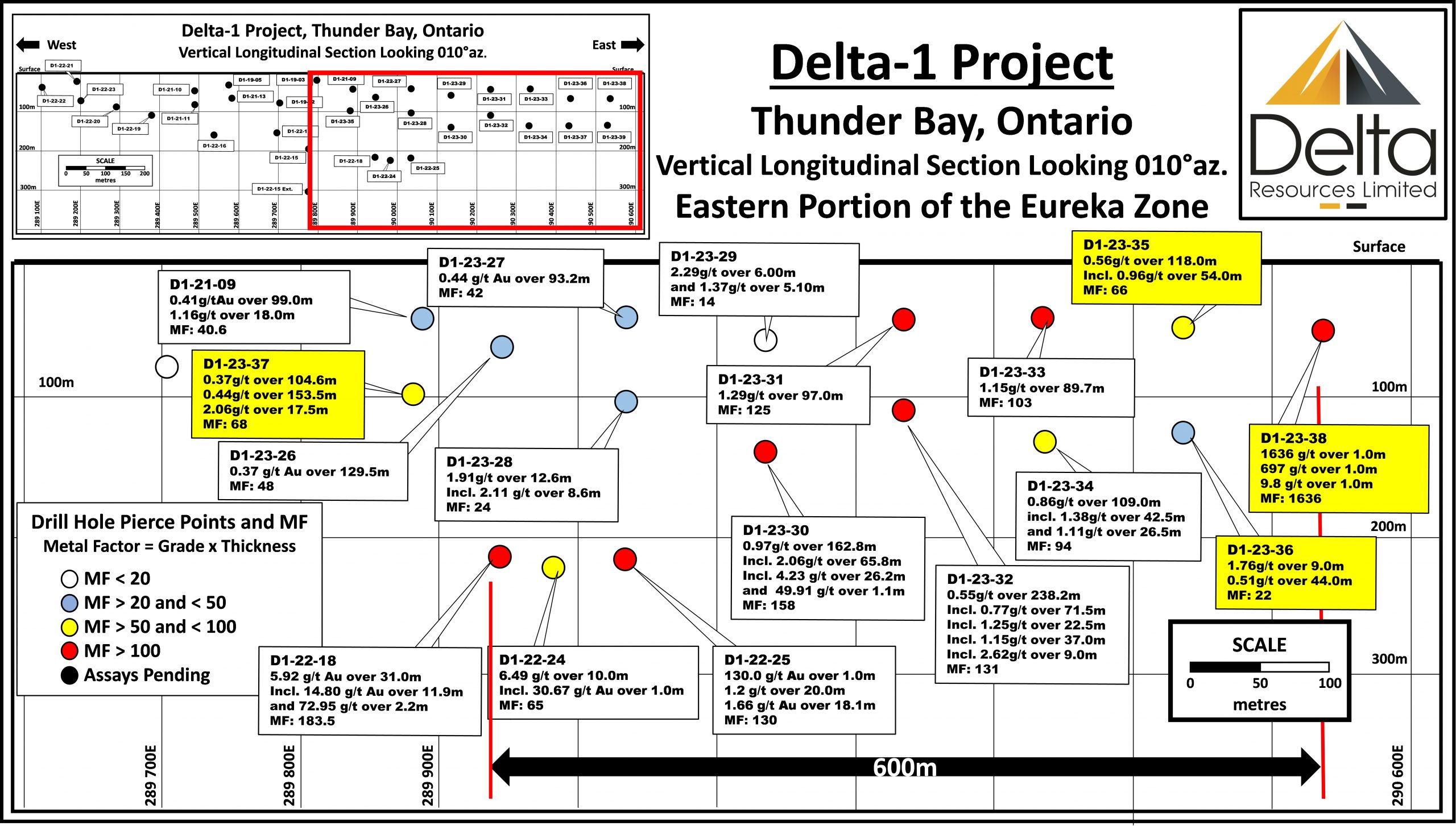
Delta Resources Limited (TSXV:DLTA) has unveiled the assay results from the concluding quartet of drill holes of the 2023 Phase 1 drill program. Furthermore, the company shared initial insights on the initial drill holes of the ambitious 5000-metre Phase 2 drilling project at the Delta-1 gold mining site, situated 50 km west of Thunder Bay, Ontario.
Substantial traces of gold mineralization were discovered near the surface in drill holes D1-23-35 and D1-23-36. This expansion of mineralization pushes the boundaries an extra 100 metres eastward from the area of previously reported drill holes.
André Tessier, President and CEO commented in a press release: “These Bonanza grades at Delta-1 are very impressive but more important is the fact that we are doing large, 100 metre step outs and are still consistently hitting strong alteration with higher-grade gold segments hosted within a broader zone of low to moderate grade gold. This speaks to the strength of the mineralizing system and the upside potential as our drilling progresses eastward into the larger “Deep Blue” target area. This deposit is certainly full of pleasant surprises. Given the limited drilling to date, we still have a lot of work ahead of us to better understand this deposit.”
Drill hole D1-23-38 intersected extraordinarily high-grade gold mineralization in narrower segments to the east of a northeast-orientated cross fault, which shifted the mineralized zone southwards. There is yet uncertainty about the correlation of this high-grade mineralization with the broader intervals of lower grade to the west of the cross structure. As is typical in large gold systems, vein widths, veining density, and grade distribution can significantly vary; hole D1-23-38 exemplifies this variability along the favourable structure and geophysical target.
Delta Resources Limited also announces the completion of the inaugural step-out drill holes from its second phase of drilling, announced on April 24, 2023. A further step out of 100 metres east of drill hole D1-23-38, the new drill holes D1-23-40 and D1-23-41, seem to signal a return to the vast intervals of gold mineralization with visible gold detected in both holes. These drill holes represent the first direct testing of the promising “Deep Blue” Target.
Drill hole D1-23-37, drilled from the same pad as D1-22-09, pierced through a broad area of alteration and low-grade gold mineralization in the Alpha and Beta Zones, with noteworthy grades found in the Gamma Zone.
The Delta-1 project is strategically situated within the Shebandowan Greenstone Belt and spans a significant 17 km strike length of the Shebandowan Structural Zone.
Highlights from the results are as follows:
TABLE 1: DELTA-1 2023 DRILL INTERCEPTS
| DRILL HOLE NO |
UTM Coordinates Zone 16 | Azimuth | Incl. | Length (m) |
ZONE | FROM (m) |
TO (m) |
Au Grade (g/t) | CORE LENGTH (m) |
|
| Easting | Northing | |||||||||
| D1-23-35 | 290464 | 5385361 | 180 | -40 | 258 | α | 25.00 | 32.00 | 1.23 | 7.00 |
| β | 89.00 | 143.00 | 0.80 | 54.00 | ||||||
| γ | 168.00 | 170.10 | 2.15 | 2.10 | ||||||
| D1-23-36 | 290464 | 5385361 | 180 | -65 | 354 | α | 41.00 | 50.00 | 1.76 | 9.00 |
| β | 137.00 | 162.50 | 0.80 | 25.50 | ||||||
| γ | 349.50 | 352.50 | 0.99 | 3.00 | ||||||
| D1-23-37 | 289883 | 5385385 | 180 | -70 | 312 | α | 18.00 | 122.60 | 0.37 | 104.60 |
| β | 141.00 | 294.50 | 0.44 | 153.50 | ||||||
| incl. | γ | 272.10 | 289.60 | 2.06 | 17.50 | |||||
| D1-23-38 | 290600 | 5385200 | 180 | -45 | 222.5 | β? | 62.80 | 63.80 | 1636.00 | 1.00 |
| β? | 69.00 | 70.00 | 697.00 | 1.00 | ||||||
| β? | 90.00 | 95.00 | 1.73 | 5.00 | ||||||
| β? | 107.00 | 108.00 | 9.78 | 1.00 | ||||||
| Results previously released for drill holes D1-22-18 to D1-23-34. α=Alpha, β=Beta, γ=Gamma | ||||||||||
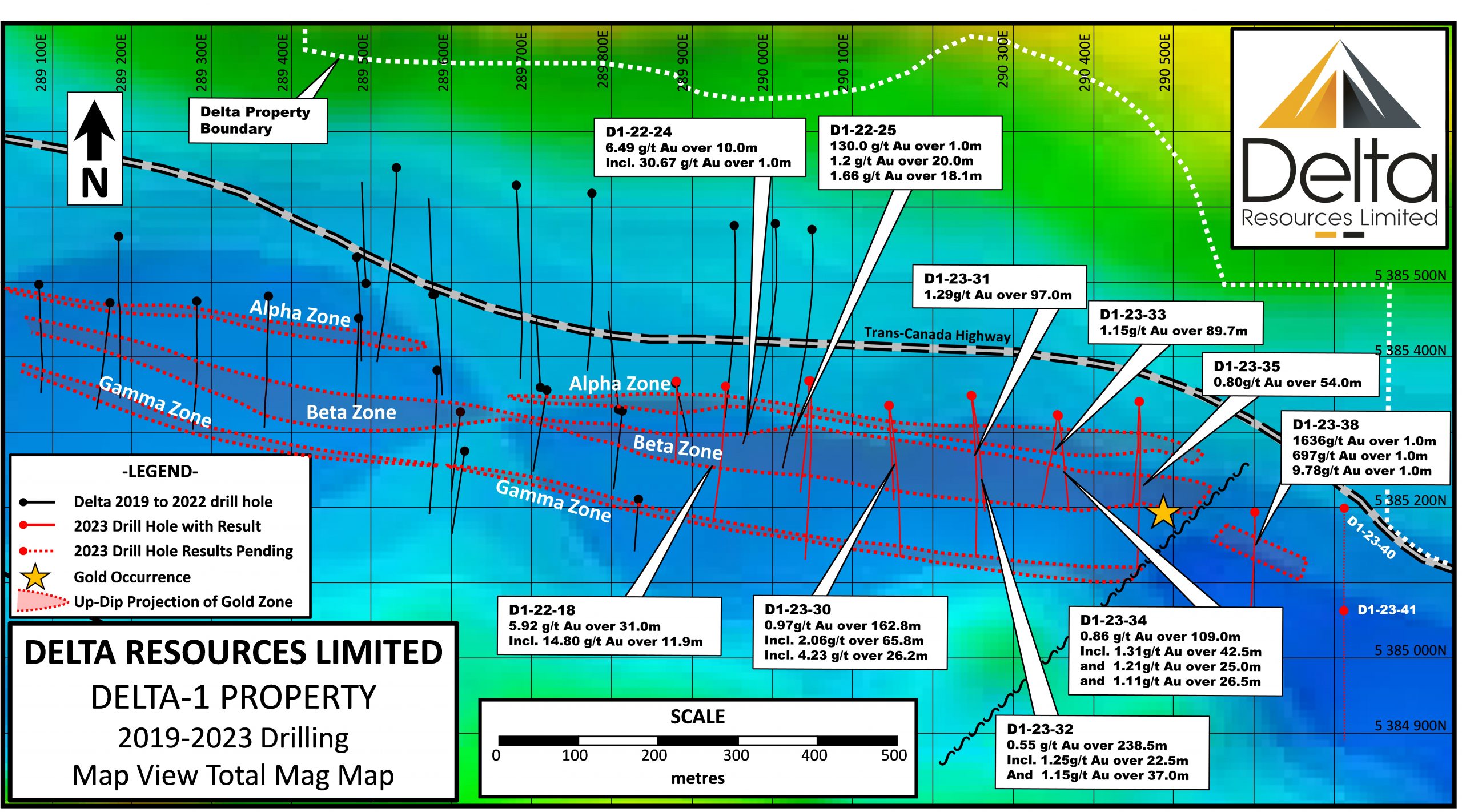
| TABLE 2: DELTA-1 2023 DRILL INTERCEPTS | ||||||||||
| DRILL HOLE NO |
UTM Coordinates Zone 16 | Azimuth | Incl. | Length (m) |
ZONE | FROM (m) |
TO (m) |
Au Grade (g/t) |
CORE LENGTH (m) |
|
| Easting | Northing | |||||||||
| D1-22-18 | 289955 | 5385581 | 180 | -45 | 453 | β | 293.00 | 324.00 | 5.92 | 31.00 |
| incl. | 308.10 | 320.00 | 14.80 | 11.90 | ||||||
| 314.00 | 316.20 | 72.95 | 2.20 | |||||||
| incl. | γ | 358.00 | 365.00 | 0.66 | 7.00 | |||||
| D1-22-24 | 290005 | 5385581 | 180 | -45 | 428 | β | 309.00 | 317.00 | 6.49 | 10.00 |
| incl. | β | 309.00 | 310.00 | 30.66 | 1.00 | |||||
| D1-22-25 | 290052 | 5385573 | 180 | -45 | 453 | α | 229.00 | 234.00 | 2.34 | 5.00 |
| 301.50 | 302.50 | 130.00 | 1.00 | |||||||
| β | 321.00 | 341.00 | 1.2 | 20.00 | ||||||
| γ | 382.90 | 401.00 | 1.66 | 18.10 | ||||||
| incl. | γ | 399.50 | 401.00 | 16.42 | 1.50 | |||||
| D1-23-26 | 289947 | 5385383 | 180 | -58 | 300 | 8.70 | 138.50 | 0.37 | 129.80 | |
| D1-23-27 | 290050 | 5385390 | 180 | -40 | 270 | α-β | 16.80 | 110.00 | 0.45 | 93.20 |
| incl. | α-β | 16.80 | 77.00 | 0.54 | 60.20 | |||||
| D1-23-28 | 290050 | 5385390 | 180 | -68 | 300 | α | 44.90 | 62.00 | 0.63 | 17.10 |
| β | 105.00 | 117.60 | 1.91 | 12.60 | ||||||
| incl. | 105.00 | 113.60 | 2.46 | 8.60 | ||||||
| D1-23-29 | 290150 | 5385360 | 180 | -40 | 231 | β | 79.00 | 85.00 | 2.29 | 6.00 |
| 85.00 | 93.90 | Late Diabase Dike | ||||||||
| β | 93.90 | 99.00 | 1.37 | 5.10 | ||||||
| D1-23-30 | 290150 | 5385360 | 180 | -65 | 303 | β+γ | 73.20 | 236.00 | 0.97 | 162.80 |
| α | 51.20 | 59.10 | 0.62 | 7.90 | ||||||
| β | 73.20 | 139.00 | 2.06 | 65.80 | ||||||
| incl. | β | 76.00 | 102.20 | 4.23 | 26.20 | |||||
| incl. | β | 79.00 | 80.10 | 49.91 | 1.10 | |||||
| γ | 217.00 | 236.00 | 0.74 | 19.00 | ||||||
| D1-23-31 | 290254 | 5385377 | 180 | -40 | 247.5 | α-β | 36.00 | 133.00 | 1.29 | 97.00 |
| α | 36.00 | 45.50 | 1.04 | 9.50 | ||||||
| β | 58.00 | 133.00 | 1.54 | 75.00 | ||||||
| incl. | β | 93.50 | 94.40 | 36.59 | 0.90 | |||||
| incl. | β | 124.10 | 125.00 | 46.81 | 0.90 | |||||
| γ | 198.00 | 204.00 | 0.79 | 6.00 | ||||||
| D1-23-32 | 290254 | 5385377 | 180 | -65 | 303 | α+β+γ | 42.30 | 280.50 | 0.55 | 238.20 |
| α+β | 42.30 | 176.00 | 0.61 | 133.70 | ||||||
| incl. | 54.00 | 76.50 | 1.25 | 22.50 | ||||||
| γ | 243.50 | 280.50 | 1.15 | 37.00 | ||||||
| incl. | 271.50 | 280.50 | 2.62 | 9.00 | ||||||
| D1-23-33 | 290363 | 5385355 | 180 | -40 | 261 | α+β | 14.80 | 104.50 | 1.15 | 89.70 |
| α | 14.80 | 36.00 | 2.87 | 21.20 | ||||||
| Incl. | α | 23.00 | 24.00 | 45.44 | 1.00 | |||||
| β | 49.00 | 104.50 | 0.73 | 55.50 | ||||||
| incl. | β | 103.00 | 104.50 | 12.05 | 1.50 | |||||
| γ | 173.50 | 193.00 | 0.72 | 19.50 | ||||||
| D1-23-34 | 290363 | 5385355 | 180 | -70 | 144.3 | α+β+γ | 33.00 | 142.00 | 0.86 | 109.00 |
| α+β | 33.00 | 75.50 | 1.31 | 42.50 | ||||||
| α | 33.00 | 45.00 | 2.08 | 12.00 | ||||||
| β | 50.50 | 75.50 | 1.21 | 25.00 | ||||||
| γ | 115.50 | 142.00 | 1.11 | 26.50 | ||||||
| D1-23-35 | 290464 | 5385361 | 180 | -40 | 258 | α | 25.00 | 32.00 | 1.23 | 7.00 |
| β | 89.00 | 143.00 | 0.80 | 54.00 | ||||||
| γ | 168.00 | 170.10 | 2.15 | 2.10 | ||||||
| D1-23-36 | 290464 | 5385361 | 180 | -65 | 354 | α | 41.00 | 50.00 | 1.76 | 9.00 |
| β | 137.00 | 162.50 | 0.80 | 25.50 | ||||||
| γ | 349.50 | 352.50 | 0.99 | 3.00 | ||||||
| D1-23-37 | 289883 | 5385385 | 180 | -70 | 312 | α | 18.00 | 122.60 | 0.37 | 104.60 |
| β | 141.00 | 294.50 | 0.44 | 153.50 | ||||||
| incl. | γ | 272.10 | 289.60 | 2.06 | 17.50 | |||||
| D1-23-38 | 290600 | 5385200 | 180 | -45 | 222.5 | β? | 62.80 | 63.80 | 1636.00 | 1.00 |
| β? | 69.00 | 70.00 | 697.00 | 1.00 | ||||||
| β? | 90.00 | 95.00 | 1.73 | 5.00 | ||||||
| β? | 107.00 | 108.00 | 9.78 | 1.00 | ||||||
| Results previously released for drill holes D1-22-18 to D1-23-34. α=Alpha, β=Beta, γ=Gamma | ||||||||||
The above references an opinion and is for information purposes only. It is not intended to be investment advice. Seek a licensed professional for investment advice. The author is not an insider or shareholder of any of the companies mentioned above.
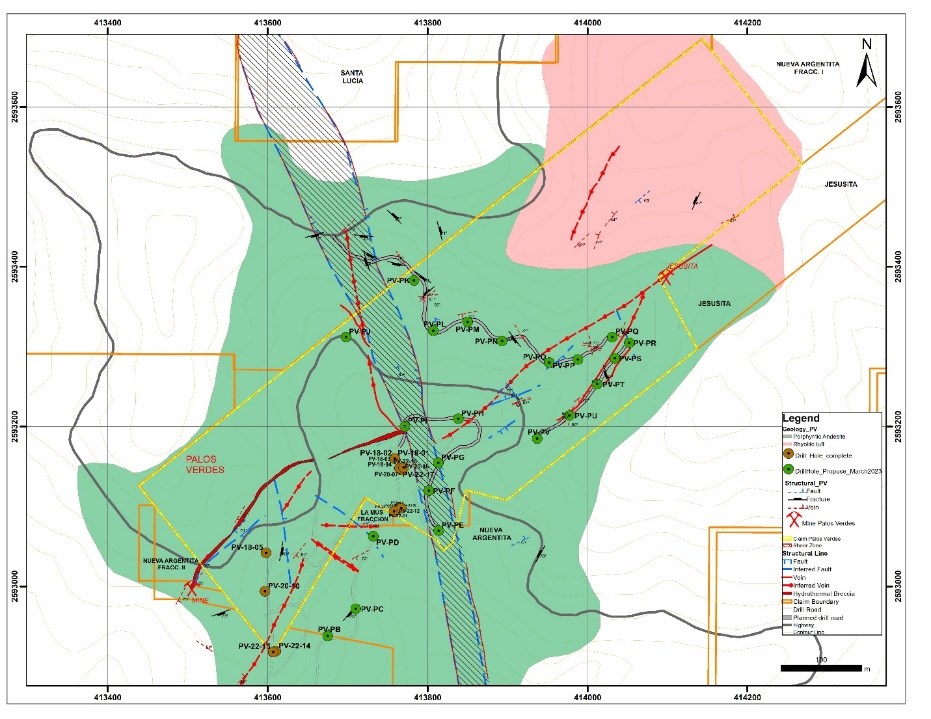
In a recent update from Prismo Metals (CSE: PRIZ), the company announced the commencement of their eagerly anticipated 2023 drilling expedition at the Palos Verdes Project, situated in the Panuco mining district, Sinaloa State, Mexico.
The company’s focus is on a comprehensive drill operation, spanning a minimum of 2,500 meters, aimed at exploring 65% of the undrilled strike length of the Palos Verdes vein, as well as other veins identified on the surface. Prismo’s exploration territory is believed to house a sizeable ore shoot, bearing resemblances to the ones unearthed by Vizsla Silver Corp. (TSXV: VZLA) on neighboring plots.
Dr. Craig Gibson, President and CEO of Prismo Metals, commented in a press release: “We are excited to begin drilling along the Palos Verdes vein in areas that were not previously accessible for drilling. The upcoming drill program will begin by testing the Palos Verdes vein to the northeast of the previous intercepts, initially with shallow drilling to confirm the orientation of the vein to be followed by deeper holes. A ten to fifteen-hole program that will take two months to complete is currently underway,” he stated.
The Palos Verdes Project shares borders with Vizsla Silver Corp.’s Panuco silver-gold endeavor. The Palos Verdes vein, with a strike length of 750 meters on Prismo’s turf, originates from Vizsla’s concession located south-west of Palos Verdes (refer to Fig. 1 for details).
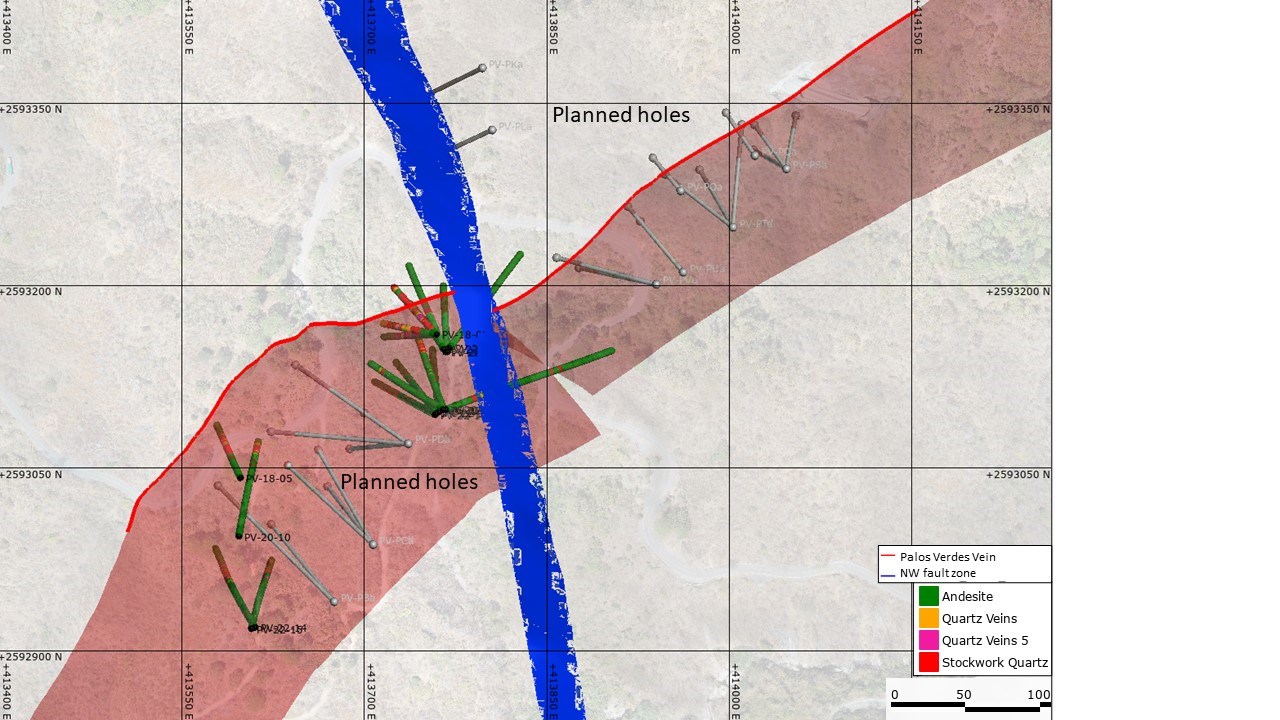
Historical drilling operations have revealed high-grade mineralization, with the most promising intercept recorded at 2,336 g/t Ag and 8.42 g.t Au across an actual width estimated at 0.8 meters. This is part of a larger mineralized span boasting 1,098 g/t Ag and 3.75 g/t Au over a true width of 2.3 meters.
The Palos Verdes project finds its home in the renowned Pánuco-Copala silver-gold district in the southern part of Sinaloa, Mexico. Positioned roughly 65 kilometers NE of Mazatlán, Sinaloa, within the Municipality of Concordia, the Palos Verdes concession encompasses 700 meters of the Palos Verdes vein’s strike length. This particular vein, a component of the north-easterly trending vein family, is located in the eastern section of the district, beyond the scope of modern exploration.
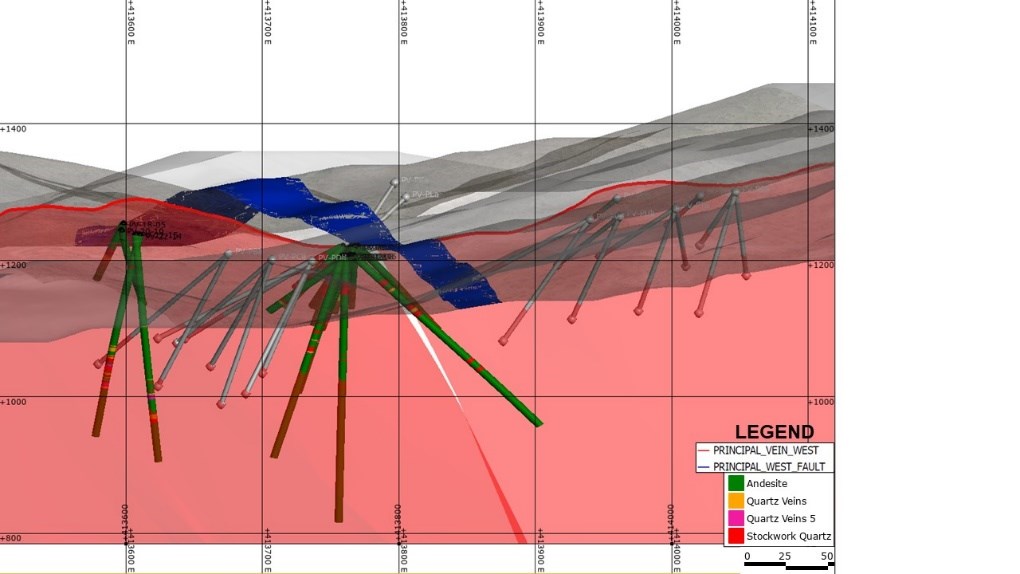
Initial shallow drilling (<100m) conducted in 2018 on the Palos Verdes Vein, aimed at regions 30 to 50 meters beneath mostly barren vein outcrops, resulted in a multistage vein discovery measuring two to seven meters in width. This vein carried thin intervals of high-grade precious metal values along with minor base metals. This mineralization remains open in all directions and the current drilling scheme is devised to trace it along its strike and depth.
The above references an opinion and is for information purposes only. It is not intended to be investment advice. Seek a licensed professional for investment advice. The author is not an insider or shareholder of any of the companies mentioned above.
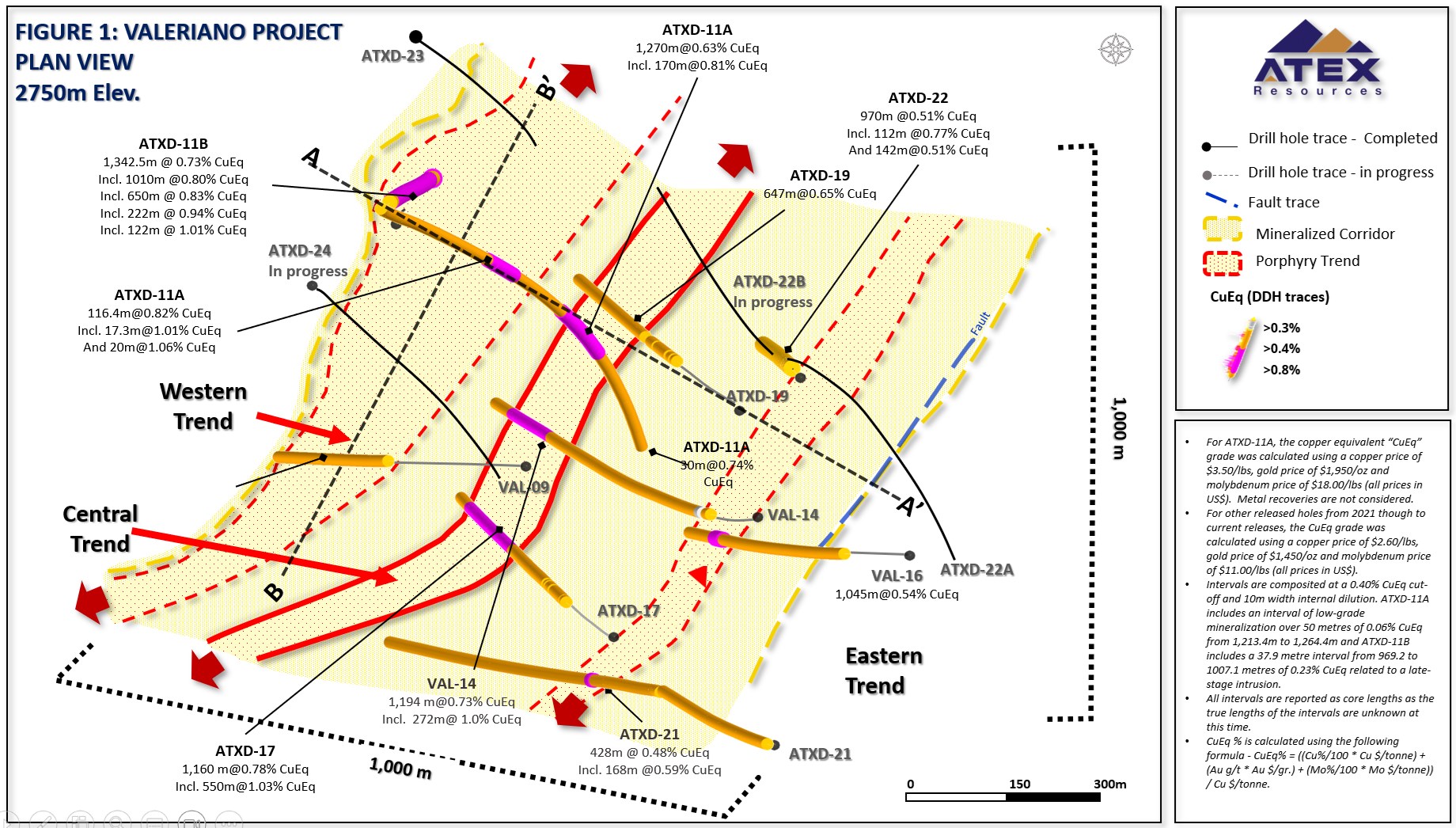
ATEX Resources Inc. (TSXV: ATX), has announced the successful completion of drill holes ATXD-22A and ATXD-23 in their ongoing Phase III exploration at the Valeriano Copper-Gold Project in Chile’s Atacama Region.
Raymond Jannas, President, and CEO of ATEX, commented in a press release: “Our Phase III drill program continues to successfully deliver on its objectives with hole ATXD-23 significantly extending the newly discovered Western Trend which remains open along strike to the northeast. We have now confirmed 750 metres of strike extent along the Western Trend between drill holes VAL-09 and ATXD-23, demonstrating continuity of the geology and mineralization within this new trend.”
The company remains committed to its Phase III campaign objectives, which include the extension of the mineralized corridor, primarily northeastwards, through meticulous step-out drilling. The campaign’s aim is to define the continuity and geometrical attributes of the porphyry trends and to identify new potential targets within this corridor.
Currently, two diamond drill holes, ATXD-24 and ATXD-22B, are in progress. The former, an inclined drill hole, is designed to intersect the Western Trend at a point 200 metres south along the strike from ATXD-11B, with a plan to reach the Central High-Grade Trend at a deeper level. The latter, a “daughter hole”, springs from ATXD-22 and is geared towards exploring the northern extension of the Central High-Grade Trend, stretching 200 metres beyond ATXD-11A.
ATXD-23, another crucial diamond drill hole, was set 200 metres north of ATXD-11B along the Western Trend. It commenced at a -83-degree dip and a 125-degree azimuth. Intriguingly, alteration began 525 metres downhole, where quartz-sericite alteration was encountered in the overlying rhyolitic tuffs. Mineralized RMB chalcopyrite was detected from 825 metres down, with the quartz-sericite alteration gradually transitioning to potassic alteration, intensifying up to 1,500 metres. At this point, the early porphyry unit’s top was intersected, revealing widespread potassic alteration and chalcopyrite from 1,500 metres to the hole’s end at 2,050 metres.
Moreover, ATXD-22A, a daughter hole drilled out of ATXD-22, started at 921 metres downhole at a 135-degree azimuth and a -65-degree dip. The hole began in RMB with chalcopyrite mineralization and weak potassic alteration, extending to a depth of 1,823.1 meters, where a significant fault was intersected, marking the end of the mineralized geology. The hole ultimately concluded at a depth of 1,871 metres.
The final drill holes of the Phase III project are anticipated to be concluded by the end of May, with comprehensive assay results expected by late July. Following the receipt of all assay results, ATEX Resources Inc. plans to revise the copper-gold porphyry resource statement for the Valeriano Project and prepare an updated NI-43 101 compliant technical report. Furthermore, the company will perform metallurgical tests using core samples from the Phase III program.
Highlights from the results are as follows:
- ATXD-23 intersected 550 metres of mineralized early porphyry, between 1,500 and 2,050 metres downhole (Figures 1&2)
- ATXD-23 extends the strike length of the Western Trend by approximately 200 metres north of hole ATXD-11B that intersected 1,342.5 metres of 0.73% CuEq (0.46% Cu, 0.31 g/t Au and 43 ppm Mo) and was released on March 30, 2023.
- Copper mineralization in the early porphyry consists mainly of chalcopyrite and to a lesser extent bornite, consistent with mineralization observed in ATXD-11B.
- Additionally, ATXD-23 intersected 650 metres of chalcopyrite-bearing Rock Milled Breccia (“RMB”) above the early porphyry interval from a depth of 850 metres downhole to the porphyry contact at 1,500 metres.
- ATXD-22A (daughter hole) drilled southeast out of ATDX-22 intersected altered chalcopyrite bearing RMB and mineralized late porphyry units.
- The final two holes of the program, ATXD-24 and ATXD-22B are anticipated to be completed by the end of May.
- Complete assays for ATXD-23 and ATXD-22A are expected by late May.
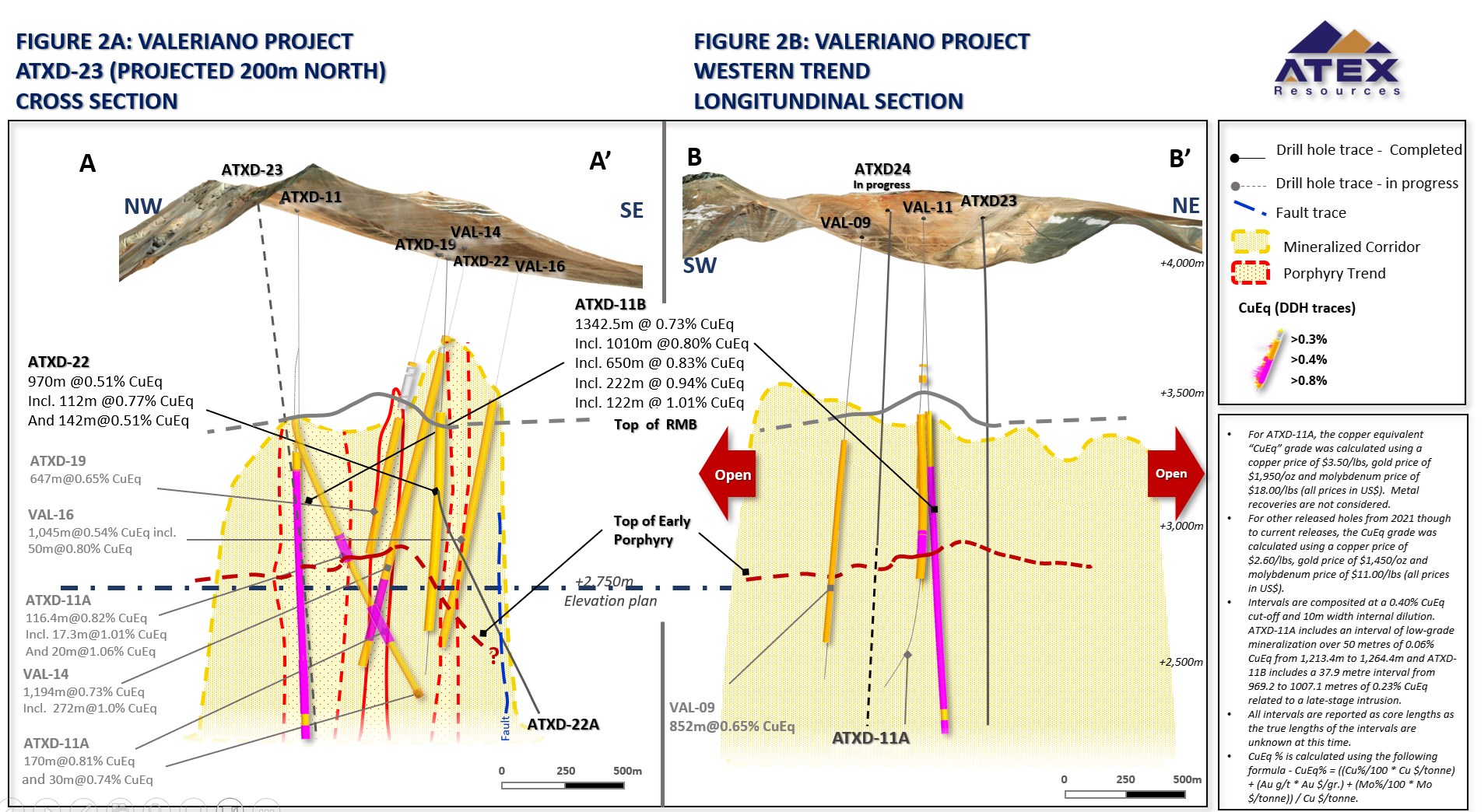
Figure 2B: Valeriano Project – Western Trend – Longitudinal Section. Source: ATEX Resources
The above references an opinion and is for information purposes only. It is not intended to be investment advice. Seek a licensed professional for investment advice. The author is not an insider or shareholder of any of the companies mentioned above.
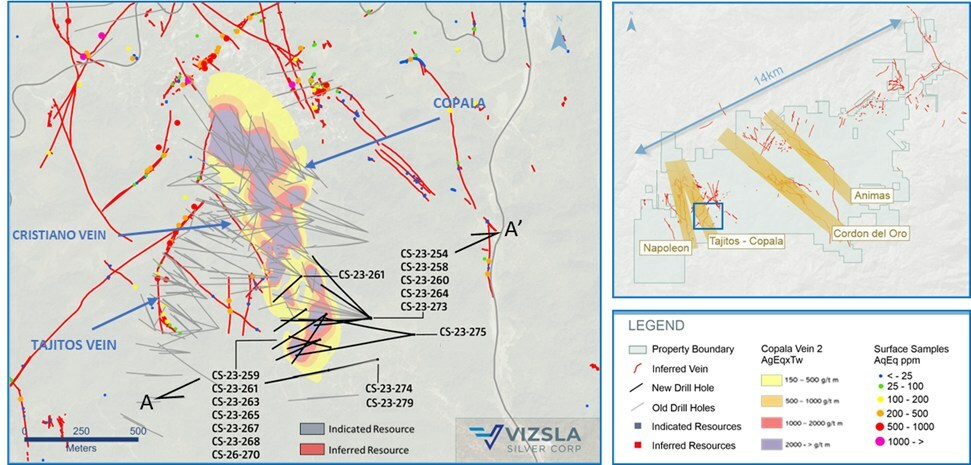
Vizsla Silver (TSXV: VZLA) has unveiled new drilling results from 16 extension holes at the Copala resource area within the company’s flagship Panuco silver-gold project in Mexico. The latest findings demonstrate a 150-meter lateral expansion of the Copala mineralized footprint to the southeast. The Copala structure, primarily composed of precious metals, is situated in the western part of the Panuco district, about 800 meters east of the Napoleon structure. Current indicated resources at Copala include 51.1 Moz AgEq at 516 g/t AgEq, with inferred resources of 55.4 Moz AgEq at 617 g/t AgEq, hosted in a broad envelope of vein-breccia and host rock up to 82 meters thick.
Michael Konnert, President & CEO, commented in a press release: “Step-out drilling along the southern extent of Copala continues to deliver high-grades over broad widths, beyond the January 2023 resource wireframes. Today’s results extend the Copala mineralized footprint by ~150m to the south of previously reported drilling and represents a potential shoot of new mineralization with a vertical profile of ~280m. We currently have four drill rigs targeting Copala, three focused on expanding the current resource base on the south and one exploration rig testing the lateral potential, to the north. With numerous open-ended intercepts containing very high silver and gold grades over large intervals up to 82m thick, the Copala structure remains a primary focus for both resource expansion and exploration ahead of the next resource update planned for the fourth quarter of 2023.”
Vizsla geologists have identified an average dip of approximately 46° to the east in the Copala structure, which varies from 35° in the northern sector to 52° in the southern sector. With ongoing drilling, mineralization has now been tracked along roughly 1,250 meters of strike length and 400 meters down dip. High-grade silver-gold mineralization remains open to the southeast and north. The recently completed resource expansion drilling, consisting of 16 holes spaced at around 100-meter intervals in Copala’s southern extent, revealed that the structure extends southeast beyond the January 2023 resource and has the potential to host additional high-grade shoots down dip. Holes CS-23-265, -270, -254, -273, and -269 all intersected precious metal-rich mineralization with grades exceeding 1,000 g/t m over a vertical distance of around 280 meters.
Vizsla has completed approximately 35,000 meters of its fully funded 90,000-meter 2023 drilling program. The Panuco silver-gold project, a recently consolidated high-grade discovery located in southern Sinaloa, Mexico, near Mazatlán, spans 7,189.5 hectares. The past-producing district boasts over 86 kilometers of total vein extent, 35 kilometers of underground mines, roads, power, and permits. The Panuco Project is home to an estimated in-situ indicated mineral resource of 104.8 Moz AgEq and an in-situ inferred resource of 114.1 Moz AgEq. An updated NI 43-101 technical report, titled “Technical Report on the Mineral Resource Estimate Update for the Panuco Ag-Au-Pb-Zn Project, Sinaloa State, Mexico,” was filed on SEDAR on March 10, 2023, with an effective date of January 19, 2023.
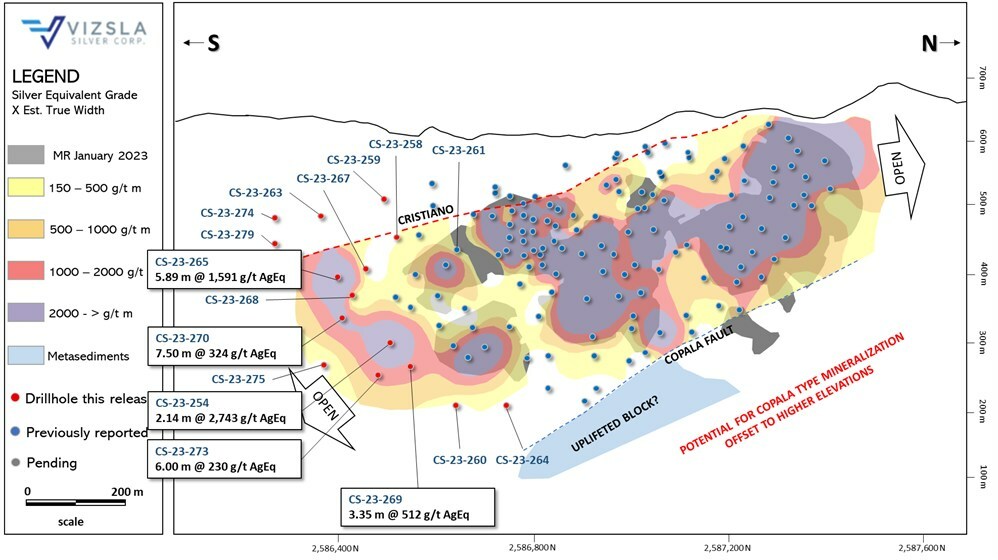
Highlights from the results are as follows:
- CS-23-265 returned 1,591 grams per tonne (g/t) silver equivalent (AgEq) over 5.89 metres true width (mTW) (1,403 g/t silver and 4.24 g/t gold)
- Including 4,842 g/t AgEq over 1.62 mTW (4,245 g/t silver and 13.24 g/t gold)
- And 396 g/t AgEq over 4.90 mTW (345 g/t silver and 1.12 g/t gold)
- Including 1,005 g/t AgEq over 1.24 mTW (923 g/t silver and 2.17 g/t gold)
- CS-23-254 returned 2,743 g/t AgEq over 2.14 mTW (1,319 g/t silver and 22.46 g/t gold)
- Including 5,222 g/t AgEq over 1.03 mTW (2,320 g/t silver and 45.40 g/t gold)
- CS-23-269 returned 1,080 g/t AgEq over 1.45 mTW (789 g/t silver and 5.13 g/t gold) hosted within a broader interval grading 512 g/t AgEq over 3.35 mTW
Table 1: Downhole drill intersections from the holes reported for Copala structure and Cristiano vein.
|
Drillhole |
From |
To |
Downhole |
Estimated |
Ag |
Au |
AgEq |
Vein |
||||
|
(m) |
(m) |
(m) |
(m) |
(g/t) |
(g/t) |
(g/t) |
||||||
|
CS-23-254 |
520.00 |
527.75 |
7.75 |
5.72 |
128 |
0.82 |
175 |
HW splay |
||||
|
CS-23-254 |
535.40 |
538.30 |
2.90 |
2.14 |
1,319 |
22.46 |
2,743 |
Copala |
||||
|
Includes |
535.40 |
536.80 |
1.40 |
1.03 |
2,320 |
45.40 |
5,222 |
|||||
|
CS-23-254 |
No significant assays |
Cristiano |
||||||||||
|
CS-23-258 |
No significant assays |
Copala |
||||||||||
|
CS-23-259 |
No significant assays |
Copala |
||||||||||
|
CS-23-259 |
215.90 |
216.30 |
0.40 |
0.38 |
321 |
1.31 |
387 |
Cristiano |
||||
|
CS-23-260 |
No significant assays |
Copala |
||||||||||
|
CS-23-261 |
No significant assays |
Copala |
||||||||||
|
CS-23-261 |
366.95 |
367.50 |
0.55 |
0.35 |
256 |
1.27 |
323 |
Cristiano |
||||
|
CS-23-263 |
No significant assays |
Copala |
||||||||||
|
CS-23-264 |
No significant assays |
Copala |
||||||||||
|
CS-23-265 |
380.60 |
388.95 |
8.35 |
5.89 |
1,403 |
4.24 |
1,591 |
Copala |
||||
|
Includes |
386.65 |
388.95 |
2.30 |
1.62 |
4,245 |
13.24 |
4,842 |
|||||
|
CS-23-265 |
402.00 |
407.95 |
5.95 |
4.90 |
345 |
1.12 |
396 |
Cristiano |
||||
|
Includes |
403.50 |
405.00 |
1.50 |
1.24 |
923 |
2.17 |
1,005 |
|||||
|
CS-23-267 |
345.00 |
346.50 |
1.50 |
1.15 |
93 |
0.61 |
127 |
Copala |
||||
|
CS-23-267 |
438.70 |
440.80 |
2.10 |
1.68 |
652 |
2.96 |
806 |
Cristiano |
||||
|
Includes |
438.70 |
440.00 |
1.30 |
1.04 |
916 |
4.31 |
1,143 |
|||||
|
CS-23-268 |
No significant assays |
Copala |
||||||||||
|
CS-23-268 |
429.35 |
430.50 |
1.15 |
1.05 |
171 |
0.89 |
219 |
Cristiano |
||||
|
CS-23-269 |
512.45 |
515.80 |
3.35 |
3.35 |
376 |
2.41 |
512 |
Copala |
||||
|
Includes |
512.45 |
513.90 |
1.45 |
1.45 |
789 |
5.13 |
1,080 |
|||||
|
CS-23-270 |
439.80 |
448.20 |
8.40 |
7.50 |
289 |
0.82 |
324 |
Copala |
||||
|
Includes |
439.80 |
441.20 |
1.40 |
1.25 |
1,220 |
2.40 |
1,297 |
|||||
|
Includes |
447.00 |
448.20 |
1.20 |
1.07 |
524 |
2.63 |
665 |
|||||
|
CS-23-270 |
475.50 |
476.40 |
0.90 |
0.75 |
284 |
1.11 |
339 |
Cristiano |
||||
|
CS-23-273 |
523.50 |
529.85 |
6.35 |
6.00 |
158 |
1.23 |
230 |
Copala |
||||
|
CS-23-274 |
No significant assays |
Copala |
||||||||||
|
CS-23-274 |
No significant assays |
Cristiano |
||||||||||
|
CS-23-275 |
No significant assays |
Copala |
||||||||||
|
CS-23-275 |
753.65 |
754.50 |
0.85 |
0.65 |
158 |
0.48 |
179 |
Cristiano |
||||
|
CS-23-279 |
No significant assays |
Copala |
||||||||||
|
CS-23-279 |
No significant assays |
Cristiano |
||||||||||
|
Note: AgEq = Ag g/t x Ag rec. + (Au g/t x Au Rec x Au price/gram)/Ag price/gram. Metal price assumptions are $24.00/oz silver and $1,800/oz gold and metallurgical recoveries assumed are 93% for silver and 90% for gold. Gold and silver metallurgical recoveries used in this release are from metallurgical test results of the Napoleon vein (see press release dated February 17, 2022). |
Table 2: Drillhole details for the reported drillholes. Coordinates in WGS84, Zone 13.
|
Drillhole |
Easting |
Northing |
Elevation |
Azimuth |
Dip |
Depth |
|
CS-23-254 |
405,085 |
2,586,570 |
696 |
266.0 |
-63.0 |
661.5 |
|
CS-23-258 |
404,834 |
2,586,561 |
651 |
271.7 |
-62.7 |
321.0 |
|
CS-23-259 |
404,798 |
2,586,610 |
637 |
235.9 |
-44.0 |
237.0 |
|
CS-23-260 |
405,085 |
2,586,570 |
697 |
307.0 |
-68.0 |
708.0 |
|
CS-23-261 |
404,778 |
2,586,756 |
629 |
227.0 |
-68.0 |
421.5 |
|
CS-23-263 |
404,860 |
2,586,478 |
662 |
245.0 |
-50.0 |
333.0 |
|
CS-23-264 |
405,085 |
2,586,570 |
697 |
314.0 |
-62.0 |
795.0 |
|
CS-23-265 |
404,861 |
2,586,478 |
662 |
254.0 |
-69.0 |
433.5 |
|
CS-23-267 |
404,888 |
2,586,590 |
664 |
235.1 |
-65.3 |
582.0 |
|
CS-23-268 |
404,906 |
2,586,444 |
654 |
287.0 |
-71.5 |
538.5 |
|
CS-23-269 |
405,085 |
2,586,570 |
697 |
281.0 |
-66.8 |
678.0 |
|
CS-23-270 |
404,888 |
2,586,590 |
664 |
215.7 |
-71.0 |
691.5 |
|
CS-23-273 |
405,084 |
2,586,574 |
700 |
260.8 |
-69.7 |
730.5 |
|
CS-23-274 |
404,898 |
2,586,343 |
648 |
259.0 |
-45.0 |
411.0 |
|
CS-23-275 |
405,275 |
2,586,500 |
670 |
261.0 |
-52.0 |
810.0 |
|
CS-23-279 |
404,898 |
2,586,343 |
648 |
259.0 |
-59.0 |
477.0 |
The above references an opinion and is for information purposes only. It is not intended to be investment advice. Seek a licensed professional for investment advice. The author is not an insider or shareholder of any of the companies mentioned above.
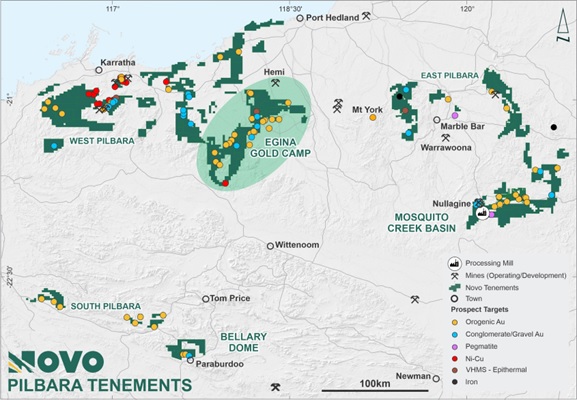
Novo Resources Corp. (TSX: NVO) has recently announced the launch of a comprehensive +20,000m aircore (AC) drilling program at the company’s flagship Becher Project, located in the northern sector of the Egina Gold Camp.
Novo Executive Co-Chairman and Acting CEO Mike Spreadborough commented on the drill program in a press release: “We are very excited to have recommenced drilling at our flagship Becher Project, as we embark on a targeted +20,000 m follow-up program for this quarter. Importantly, results from our 2022 drill program have confirmed the right geological indicators for discovery success and we believe there is significant prospectivity in the Becher area.”
The Becher Area (E47/3673), 100%-owned by Novo, boasts multiple high-priority orogenic gold targets under shallow cover in the highly prospective, yet under-explored, Mallina Basin. The project is situated approximately 28 km west-southwest of De Grey Mining Limited’s Hemi deposit and along an interpreted gold-fertile corridor, just 2.5 km south of their recent Withnell South discovery.
Novo’s 2022 drilling program has proven to be extremely successful on several fronts:
- Gold assay results from drill sampling provide confidence in the fertility of the interpreted regional structural corridors.
- Multi-element analysis of bottom-of-hole AC drill samples revealed intrusion-related “sanukitoid” signatures, known hosts to gold mineralization elsewhere in the district.
- The distribution of pathfinder elements such as arsenic, antimony, and tungsten helped finesse understanding of the controls on gold mineralization.
- The realization that the cover sequence is shallow (generally less than 10m) and less consequential than expected is particularly noteworthy.
These findings will significantly influence the targeting and prioritization of the 2023 drill programs.
Final results have been received for 1m split samples sourced from 4m composite samples in the reverse circulation (RC) and AC drilling completed in 2022. The new results closely mirror intercepts from previously reported composite samples and include high-grade assays as follows:
- 1m @ 7.27 g/t Au from 9m (F0632) at the intersection of the Irvine and Heckmair trends
- 1m @ 3.1 g/t Au from 17m (F519) at Whillans
- 1m @ 4.27 g/t Au from 17m (F1393) at Bonatti
New results also highlight potential for Intrusion Related Gold (IRG) mineralization at Irvine South, supported by highly anomalous Au-Cu results and associated pathfinder elements (Au-Ag-Cu-Bi-Mo-Sb) in AC on the most southerly line drilled in 2022. The presence of a strong magnetic target, coincident with the edge of current drill coverage and its location immediately west of the Becher epithermal vein system, provides further support for this possible target style.
The current AC program will test multiple high-priority structural and intrusion-hosted gold targets, similar to De Grey’s Mallina Gold Project. These targets have been defined by significant gold and pathfinder anomalies in an area of approximately 20 sq km, delineated in anomalous structural corridors at the Heckmair, Irvine, and Whillans prospects. Additional targets are also emerging from partly completed reconnaissance drilling at Lowe and Bonatti. A minimum of 20,000m of AC will be conducted as part of the program, which commenced in mid-April 2023 and will be completed in June 2023.
2022 Exploration Program Details
In mid-2022, Novo commenced a major exploration campaign to test multiple significant shear corridors adjacent to De Grey’s 10.6 Moz Au (JORC 2012) Mallina Gold Project. Numerous targets
were generated from detailed ground magnetic surveys, regional and local scale geochemical programs, and geological mapping. The 2022 exploration program comprised:
- 9,200m of AC drilling
- 1,000m of RC drilling
- 6,000m of diamond drilling
- Detailed mapping and rock chip sampling
The 2022 drilling campaign successfully identified multiple high-grade gold intercepts, broad mineralized zones, and a new Intrusion-Related Gold (IRG) target. The results from this exploration program have expanded Novo’s understanding of the mineralization and structural controls within the Becher Project area.
Irvine South Target
The 2022 program identified the Irvine South target, which shows potential for IRG mineralization. A highly anomalous Au-Cu signature was found in AC drilling on the southernmost line, supported by associated pathfinder elements (Au-Ag-Cu-Bi-Mo-Sb). The presence of a strong magnetic target along the edge of the current drill coverage and its proximity to the Becher epithermal vein system further supports this new target style.
2023 Exploration Program Details
The 2023 AC drilling program will test multiple high-priority gold targets that have been identified by significant gold and pathfinder anomalies within a 20 sq km area at the Heckmair, Irvine, and Whillans prospects. Additional targets are also emerging from partly completed reconnaissance drilling at Lowe and Bonatti. The program will include a minimum of 20,000m of AC drilling, which commenced in mid-April 2023 and will be completed by June 2023.
Upcoming Drilling Plans
The company’s near-term plans include additional follow-up AC drilling in areas of the project that have demonstrated significant potential. Diamond drilling will also be conducted to test high-grade mineralization at depth and to provide more precise information on the structural and lithological controls on gold mineralization.
The above references an opinion and is for information purposes only. It is not intended to be investment advice. Seek a licensed professional for investment advice. The author is not an insider or shareholder of any of the companies mentioned above.
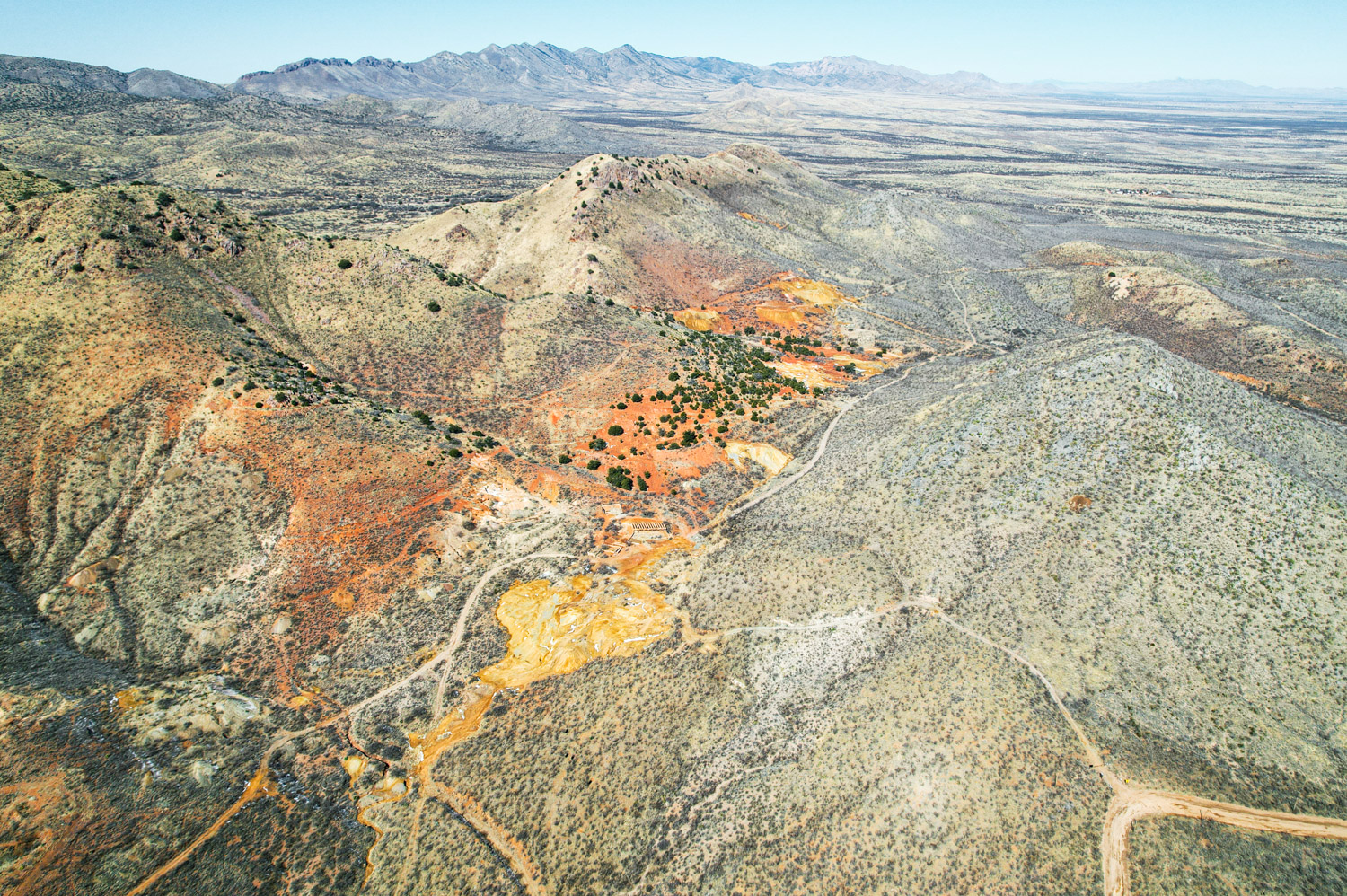
Mark Morabito, a seasoned investor and developer in the mining industry, is no stranger to identifying and seizing opportunities. From Labrador’s boreal forests to Arizona’s deserts, Morabito’s journey in mining and resource development spans over two decades. As CEO of King & Bay and head of several other public and private companies, he has led the charge on some of the most successful ventures in the sector. Now, as the founder of Intrepid Metals Corp., (TSXV:INTR) Morabito’s sights are set on the Corral Copper and Silver project in the Tombstone area of southwest Arizona.
A Foundational Career
Mark Morabito’s career began as a corporate finance and securities lawyer in Toronto and Vancouver. After eight years of tireless work, he transitioned to the client side, amassing a background in merchant banking, corporate development, and junior mining. His business acumen and talent for recognizing opportunities allowed him to create and lead multiple resource development companies. At Alderon Iron Ore, for example, Morabito’s expertise in negotiation and trailblazing secured a $400 million agreement with HBIS Group, China’s largest steel producer at the time.
As the founder of King & Bay, a merchant bank and public company services provider, Mark Morabito has focused on identifying, funding, developing, and managing business opportunities within and beyond the mining sector. To date, he has raised over US$1 billion in his career. With Intrepid Metals, Morabito aims to leverage his experience and track record to make a significant impact on the copper and silver mining landscape in Arizona.
An Intrepid Endeavour
Intrepid Metals Corp.’s (TSXV:INTR) Corral Copper Project is an advanced exploration and development opportunity in Cochise County, Arizona, offering an impressive land package of over 8,500 acres (more than 13 square miles) of mineral rights. The region has a rich mining history dating back to the late 1800s and is well-positioned for an ESG-focused future. With access to excellent infrastructure, a skilled local workforce, and tier-one mining jurisdiction status, Arizona presents an ideal environment for Intrepid Metals to thrive.
Despite the challenges of fragmented land ownership and commercial disputes in the region, Intrepid Metals has consolidated key land positions and forged positive relationships with local stakeholders. Leveraging over 50,000 meters of historical drilling data and modern exploration techniques, the company is well-equipped to move the Corral Copper Project toward the development stage and feasibility level studies.
Intrepid Metals Corp.’s Corral Copper Project offers considerable potential from a mining perspective. The project is characterized by near-surface mineralization of copper, silver, zinc, and gold, with a 2km trend of mineralized material. The district itself has a long history of small-scale mining, with over 48 million pounds of copper produced at grades up to 9.2% based on historical reports.
To date, the company has consolidated a robust land package of over 8,500 acres, including over 1,700 acres of patented mining claims and surface rights. This consolidation has allowed Intrepid to access drill logs and analytical data, providing valuable insights into the region’s geological makeup. The company has also acquired Anglo American’s data package, which identified carbonate replacement deposits and porphyry copper targets in the district.
Intrepid Metals Corp. is also committed to responsible development and utilizing modern exploration techniques in conjunction with historical data. The company’s approach to the Corral Copper Project is comprehensive, with a focus on creating geological interpretations and identifying new target areas.
Making Strides in Arizona’s Mining Landscape
Leading the way, Intrepid Metals’ management team is composed of experienced professionals with a proven track record of value creation. The company has ambitious plans this year for the Corral Copper Project, including a 30-hole drill program and up to 6,000 meters of drilling. This initiative aims to confirm historical data, extend the depth and projection of mineralization, and explore untested areas within the mineralized trend.
Drawing from Mark Morabito’s extensive experience and proven track record in resource development, the company is making major strides in Arizona’s mining landscape. With a strong foundation in place and a clear vision for the future, Intrepid Metals is well-positioned to deliver substantial value to its stakeholders and the broader mining industry with a captain at the helm who has charted the course from exploration to development, to unlocking full project potential time and time again.
The above references an opinion and is for information purposes only. It is not intended to be investment advice. Seek a licensed professional for investment advice. The author is not an insider or shareholder of any of the companies mentioned above.
AbraSilver (TSXV:ABRA) has announced promising diamond drill assay results from its ongoing Phase III exploration program at its fully-owned Diablillos project in Salta Province, Argentina. The drilling at the JAC zone continues to reveal high-grade silver oxide mineralization at shallow depths, accompanied by gold and underlying copper and silver mineralization in sulphides.
John Miniotis, President and CEO, commented in a press release: “Our drill results continue to encounter multiple thick intercepts of oxide silver in virtually every hole as we increase confidence and extend the size of the new high-grade JAC discovery. The JAC zone features a highly attractive combination of scale, grade and continuity, which is expected to significantly increase the economics of our Diablillos project. We look forward to additional drill results and incorporating all the data into an updated Mineral Resource estimate later this year.”
Dave O’Connor, Chief Geologist, also commented: “Today’s drill results further define and expand the high-grade core area of the new JAC zone. Additionally, the contact zone between the oxides and underlying sulphides continues to show substantial potential for an extensive zone of high-grade silver dominant mineralisation at the base of the oxide zone as well as for significant underlying copper sulphide mineralisation with associated precious metal content.”
Significant findings from the recent JAC zone drilling include:
- DDH 23-017, designed to examine the JAC zone’s southwest extension, discovered several silver mineralization zones in oxides, including a 12.0-meter section with 876.1 g/t Ag at a 92.0-meter downhole depth.
- DDH 23-020, aimed at the JAC zone’s northern margin, intersected multiple silver and gold mineralization zones in oxides, such as a 19-meter section with 149.5 g/t Ag and 0.78 g/t Au at a 127.0-meter downhole depth.
- DDH 23-021, located in the southeastern drill target area, encountered high-grade silver mineralization in oxides, including a 32.0-meter section with 530.8 g/t Ag and 0.60 g/t Au at a 161.5-meter downhole depth.
To date, AbraSilver has drilled around 20,000 meters in 85 holes, as part of the 22,000-meter Phase III program, mainly targeting the JAC zone. The exploration findings will form the basis for an updated Mineral Resource Estimate (MRE) and will be included in a Pre-Feasibility Study on the Diablillos project, expected to be completed in the second half of 2023.
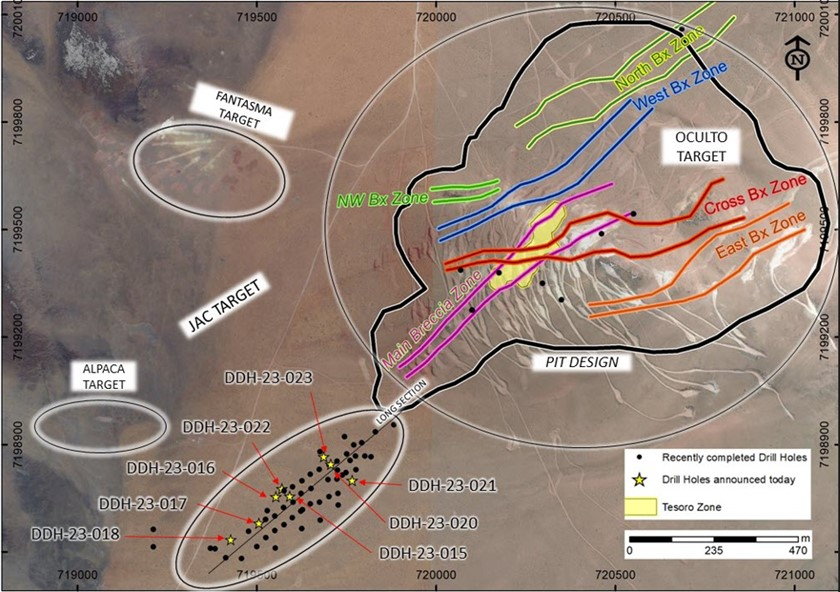
Additional exploration targets southwest of the Oculto MRE have been identified based on the recently completed detailed ground magnetic survey. Some of these targets, including the Fantasma and Alpaca targets, are expected to be drilled following the systematic drilling of the JAC zone.
The La Coipita project saw the completion of a deep hole reaching 1,242 meters. The company has finalized core splitting and sent final sample shipments to the lab. Assay results are anticipated around late June and will be reported upon receipt and interpretation.
The 80 km2 Diablillos property, acquired by AbraSilver from SSR Mining Inc. in 2016, is situated in the Argentine Puna region. The property hosts several known mineral zones, with the most advanced being the Oculto zone, where over 120,000 meters have been drilled to date.
Table 1 – Diablillos Drill Result Highlights in JAC Zone (Intercepts greater than 2,000 gram-metres AgEq shown in bold text):
| Drill Hole | From (m) |
To (m) |
Type | Interval (m) |
Ag g/t | Au g/t | Cu % | AgEq1 g/t | ||
| DDH-23-015 | 103.0 | 118.0 | Oxides | 15.0 | 84.1 | – | – | 84.1 | ||
| DDH-23-016 | 61.0 | 88.0 | Oxides | 27.0 | 46.2 | 0.01 | – | 47.0 | ||
| DDH-23-017 | 92.0 | 104.0 | Oxides | 12.0 | 876.1 | – | – | 876.1 | ||
| DDH-23-017 | Includes | 94.0 | 96.0 | Oxides | 2.0 | 4,968.4 | 0.14 | – | 4,979.9 | |
| DDH-23-017 | 110.0 | 113.0 | Oxides | 3.0 | 72.4 | – | – | 72.4 | ||
| DDH-23-017 | 132.0 | 134.0 | Oxides | 2.0 | 77.0 | – | – | 77.0 | ||
| DDH-23-018 | 108.0 | 130.0 | Oxides | 22.0 | 51.8 | – | 51.8 | |||
| DDH-23-018 | 151.0 | 160.5 | Sulphides | 9.5 | 47.2 | – | 0.67 | 47.2 | ||
| DDH-23-018 | 171.0 | 175.5 | Sulphides | 4.5 | 65.8 | – | 0.46 | 65.8 | ||
| DDH-23-020 | 79.5 | 89.5 | Oxides | 10.0 | 161.5 | – | – | 161.5 | ||
| DDH-23-020 | 92.5 | 99.0 | Oxides | 6.5 | 47.2 | 0.02 | – | 48.8 | ||
| DDH-23-020 | 104.0 | 122.0 | Oxides | 18.0 | 66.7 | 0.12 | – | 76.5 | ||
| DDH-23-020 | 127.0 | 146.0 | Oxides | 19.0 | 149.5 | 0.78 | – | 213.4 | ||
| DDH-23-020 | 148.0 | 151.0 | Oxides | 3.0 | 79.7 | 0.13 | – | 90.3 | ||
| DDH-23-021 | 137.0 | 143.0 | Oxides | 6.0 | 63.1 | 0.03 | – | 65.6 | ||
| DDH-23-021 | 156.0 | 157.0 | Oxides | 1.0 | 49.2 | 0.82 | – | 116.4 | ||
| DDH-23-021 | 161.5 | 193.5 | Oxides | 32.0 | 530.8 | 0.60 | – | 579.9 | ||
| DDH-23-021 | 193.5 | 199.5 | Sulphides | 6.0 | 52.6 | – | 1.32 | 52.6 | ||
| DDH-23-022 | 53.5 | 79.0 | Oxides | 25.5 | 58.6 | 0.01 | – | 59.4 | ||
| DDH-23-023 | 50.5 | 110.0 | Oxides | 59.5 | 103.4 | 0.05 | – | 107.5 | ||
| DDH-23-023 | 143.0 | 147.0 | Oxides | 4.0 | 86.8 | – | – | 86.8 | ||
Note: All results in this news release are rounded. Assays are uncut and undiluted. Widths are drilled widths, not true widths. True widths are estimated to be approximately 80% of the interval widths.
1AgEq based on 81.9(Ag):1(Au) calculated using long-term prices of US$25.00/oz Ag and US$1,750/oz Au, and 73.5% process recovery for Ag, and 86.0% process recovery for Au as demonstrated in the Company’s Preliminary Economic Assessment in respect of Diablillos dated January 13, 2022, using formula: AgEq g/t = Ag g/t + Au g/t x (Gold Price/Silver Price) x (Gold Recovery/Silver Recovery).
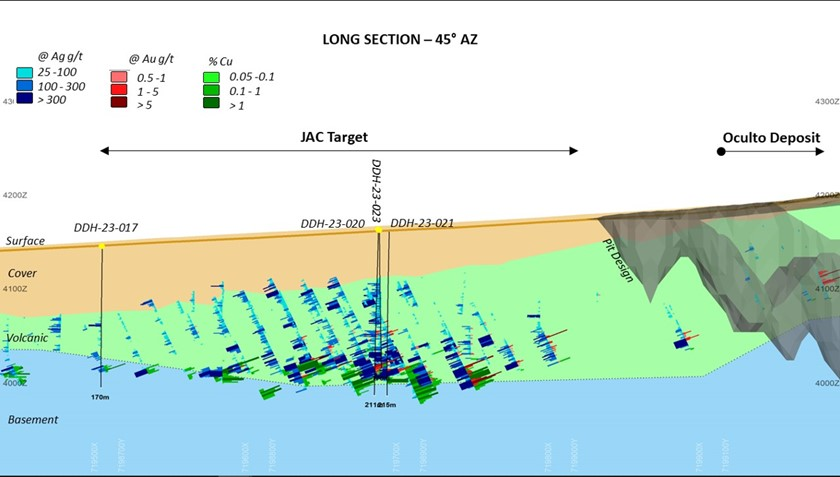
Collar Data
| Hole Number | UTM Coordinates | Elevation | Azimuth | Dip | Depth (m) | |
| DDH 23-015 | E719591 | N7198755 | 4,159 | 315 | -60 | 179 |
| DDH 23-016 | E719552 | N7198754 | 4,156 | 315 | -60 | 170 |
| DDH 23-017 | E719505 | N7198680 | 4,151 | 0 | -60 | 170 |
| DDH 23-018 | E719427 | N7198634 | 4,145 | 315 | -60 | 203 |
| DDH 23-020 | E719705 | N7198845 | 4,169 | 0 | -60 | 211 |
| DDH 23-021 | E719765 | N7198755 | 4,175 | 0 | -60 | 215 |
| DDH 23-022 | E719570 | N7198766 | 4,160 | 0 | -60 | 161 |
| DDH 23-023 | E719686 | N7198866 | 4,168 | 315 | -60 | 170 |
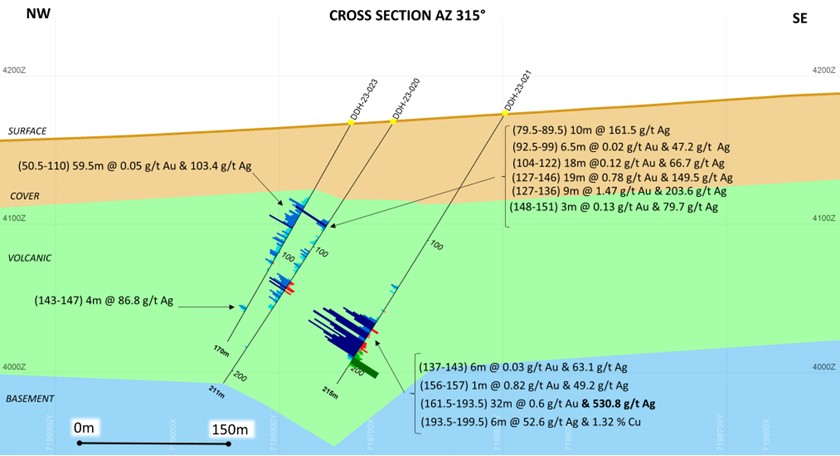
Table 2 – Oculto Mineral Resource Estimate – As of October 31, 2022
| Category | Tonnage (000 t) |
Ag (g/t) | Au (g/t) | Contained Ag (000 oz Ag) |
Contained Au (000 oz Au) |
| Measured | 19,336 | 98 | 0.88 | 60,634 | 544 |
| Indicated | 31,978 | 47 | 0.73 | 48,737 | 752 |
| Measured & Indicated | 51,314 | 66 | 0.79 | 109,370 | 1,297 |
| Inferred | 2,216 | 30 | 0.51 | 2,114 | 37 |
Notes: Effective October 31, 2022. Mineral Resources are not Mineral Reserves and have not demonstrated economic viability. The Mineral Resource estimate is N.I. 43-101 compliant and was prepared by Luis Rodrigo Peralta, B.Sc., FAusIMM CP(Geo), Independent Consultant. The mineralization estimated in the Mineral Resource is sub-horizontal with sub-vertical feeders and a reasonable prospect for eventual economic extraction by open pit methods. For additional information please see Technical Report on the Diablillos Project, Salta Province, Argentina, dated November 28, 2022, completed by Mining Plus, and available on www.SEDAR.com.
The above references an opinion and is for information purposes only. It is not intended to be investment advice. Seek a licensed professional for investment advice. The author is not an insider or shareholder of any of the companies mentioned above.
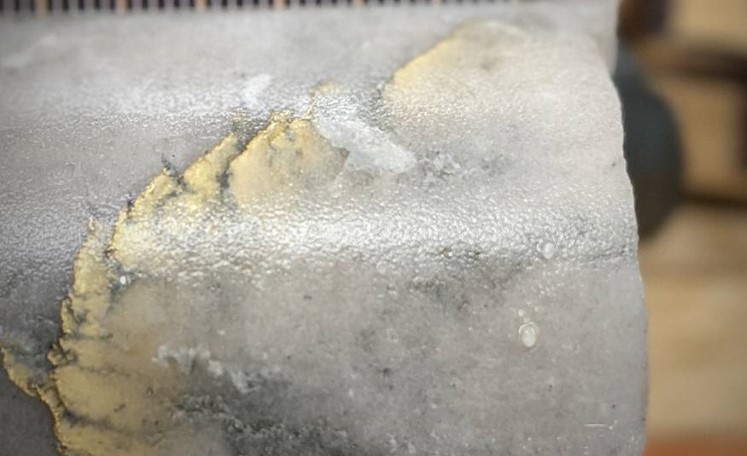
South African mining giant Gold Fields announced on Tuesday that it has formed a joint venture with Canada’s Osisko Mining (TSX:OSK) to develop the Windfall gold mining project in Canada. This strategic partnership marks Gold Fields’ long-awaited entry into the Canadian mining sector.
Stay informed with the latest in the precious metals industry In order to acquire a 50% stake in the Windfall project, Gold Fields will initially invest C$300 million ($220.85 million), with an additional C$300 million due once the Canadian government grants construction and operating permits. The company has financed the initial C$300 million through existing cash reserves and debt facilities.
Gold Fields’ attempt to enter the Canadian market faced a setback last November when its bid to acquire Yamana Gold was outmaneuvered by Agnico Eagle and Pan American Silver Corp. Despite the setback, Gold Fields continued to explore various opportunities in the Abitibi region of Canada before ultimately choosing Windfall.
Interim CEO of Gold Fields, Martin Preece, expressed his enthusiasm for the partnership in a statement, saying, “We are very pleased to be partnering with Osisko to bring the high-quality Windfall Project into production and believe that this will be the first mine of several in this partnership in a highly prospective region.”
According to a feasibility study conducted by Gold Fields, the Windfall project is expected to have an initial mine life of 10 years, producing an average of 294,000 ounces of gold annually. This level of production could potentially rank it among Canada’s top 10 largest gold mines.
On March 16, Gold Fields and AngloGold Ashanti revealed plans to merge their adjacent Tarkwa and Iduapriem mines in Ghana, creating the largest gold mine in Africa.
After its unsuccessful attempt to acquire Yamana, Gold Fields has shifted its strategy away from pursuing major mergers and acquisitions. The company will instead focus on incremental growth through targeted asset purchases.
The above references an opinion and is for information purposes only. It is not intended to be investment advice. Seek a licensed professional for investment advice. The author is not an insider or shareholder of any of the companies mentioned above.
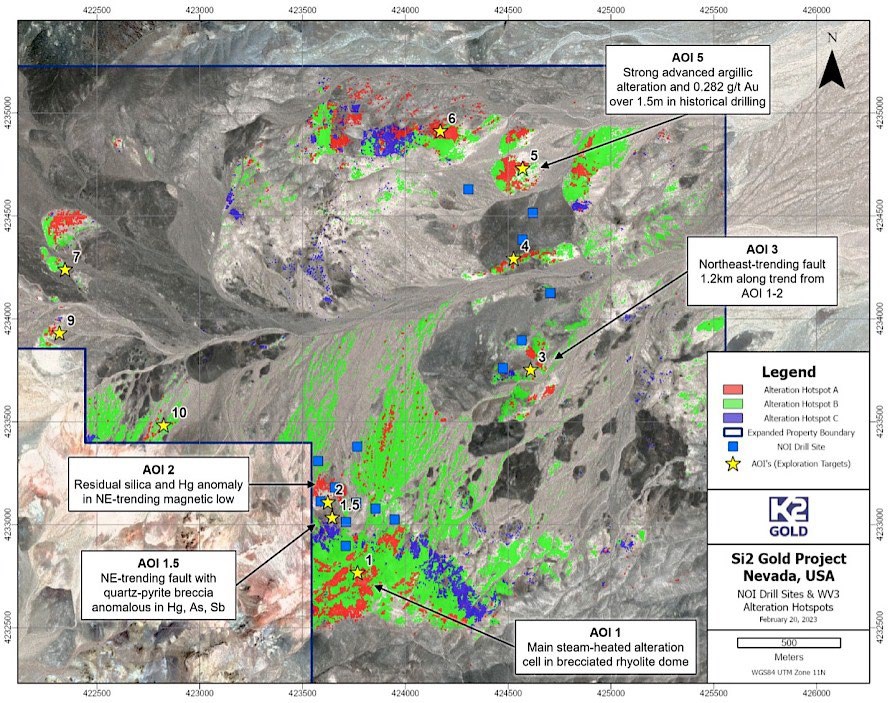
K2 Gold Corporation (TSXV:KTO) has launched its 2023 diamond drilling program at the Si2 Gold Project, aiming to extract at least 2,500 meters of diamond drill core. The program will concentrate on the “areas of interest” (AOI), specifically AOI1, AOI1.5, and AOI2 target zones. Drill holes are strategically designed to intersect the steeply northwest-dipping fault structures believed to be responsible for the extensive steam-heated alteration and mercury anomalism documented by K2 at the surface. These fault structures are thought to be the primary fluid channels within the system, potentially carrying mineralizing hydrothermal fluids.
Anthony Margarit, President, and CEO of K2 Gold, commented in a press release: “Since acquiring the Si2 project in January 2022 the Team at K2 has rapidly advanced the understanding of the project geology and defined very compelling targets. We are excited to get this drill program underway. The aim of the program is to test fault structures which control the extensive steam-heated surficial alteration we see at surface. We are targeting these structures at depth in order to sample the potentially gold bearing ‘boiling zone’ of the epithermal system.”
The drilling will target depths of at least 100 meters below the surface and beyond. The Si2 Gold Project is situated in Esmeralda County, Nevada, roughly 60 kilometres northwest of Tonopah, Nevada, and 20 kilometres northwest of Allegiant Gold’s Eastside deposit (1.4Moz Au, 8.8 Moz Ag). The project boasts road accessibility and encompasses 118 BLM lode claims spanning 986 hectares, with 65 claims under option from Orogen Royalties Inc. (TSXV: OGN). The claims cover an 8 square kilometre area characterized by steam heated alunite-kaolinite-buddingtonite alteration within a sequence of felsic to intermediate volcanic rocks displaying brecciation and a high mercury anomaly.
Additionally, K2 Gold announced the allocation of 2,775,000 incentive stock options to select Directors, Officers, Employees, and Advisors of the company. The options can be exercised at $0.15 per share for a period of five years from the grant date, with 25% vesting upon grant and subsequent 25% vesting every three months. The options were granted according to K2’s shareholder-approved stock option plan and adhere to the policies of the TSX Venture Exchange and any relevant regulatory hold periods.
The above references an opinion and is for information purposes only. It is not intended to be investment advice. Seek a licensed professional for investment advice. The author is not an insider or shareholder of any of the companies mentioned above.
Solaris Resources Inc. (TSX:SLS) has announced the identification of an additional, significantly more mineral-rich porphyry centre located 350 meters south of the initial finding at Warintza East. This new discovery presents promising prospects for enhanced grades and further expansion of the Warintza Project in the southeastern region of Ecuador.
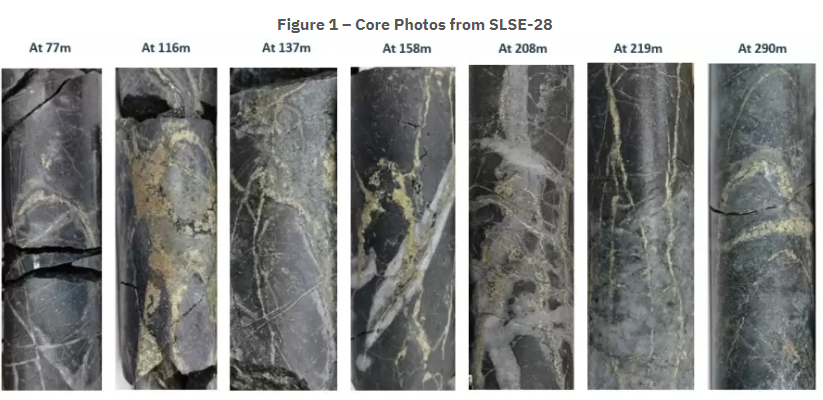
- Warintza East was discovered in July 2021, with eight holes included in the Warintza Central Mineral Resource Estimate (“MRE”)¹ in April 2022 and subsequent drilling significantly expanding the dimensions of the deposit – the latest drilling in SLSE-28 has confirmed the discovery of a second and more intensely mineralized porphyry center 350m south of the original discovery
- SLSE-28 was drilled vertically to the limit of the KD-200 rig at 309m with strong mineralization from 19m to the end of the hole characterized by chalcopyrite-pyrite-molybdenite in stockwork veins and disseminations, similar to the high grade portions of the Warintza Central deposit
- Full assay results from SLSE-28 are expected within four to six weeks while follow-up hole
SLSE-29 (in progress) is being drilled southeast from a recently constructed platform testing the extension of this new porphyry center up to 200m to the east in this area
- This new porphyry center is located on the southern margin of Warintza East drilling and correlates with mineralization encountered in the high grade portion of prior hole SLSE-16 in this area (192m of 0.70% CuEq² – refer to press release dated April 3, 2023)
- The reader should be cautioned that only assay results from a certified third-party laboratory can confirm whether concentrations of metals are present in these drill holes and, as such, visual core characterization presented herein should be viewed as speculative in nature
- MRE drilling program continues: the 2022 MRE is based on drilling to the end of 2021, with ongoing drilling aimed at expanding the ‘Indicative Starter Pit’³ and overall mineral resources, notably from the Warintza East deposit
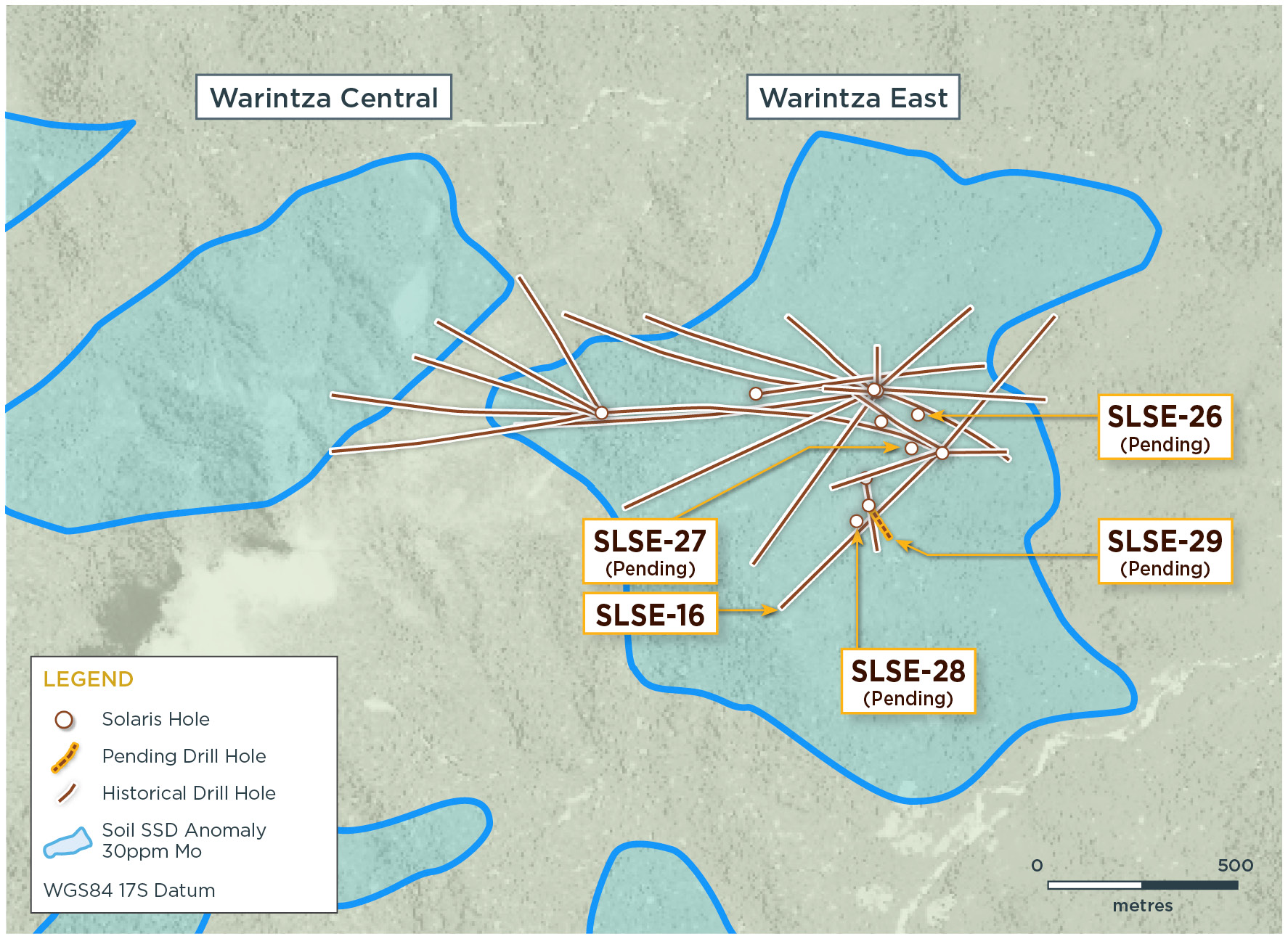
The above references an opinion and is for information purposes only. It is not intended to be investment advice. Seek a licensed professional for investment advice. The author is not an insider or shareholder of any of the companies mentioned above.
If you would like to receive our free newsletter via email, simply enter your email address below & click subscribe.
CONNECT WITH US
Tweets
Tweet with hash tag #miningfeeds or @miningfeeds and your tweets will be displayed across this site.
MOST ACTIVE MINING STOCKS
Daily Gainers
 Lincoln Minerals Limited Lincoln Minerals Limited |
LML.AX | +125.00% |
      |
GCR.AX | +33.33% |
      |
CASA.V | +30.00% |
      |
AHN.AX | +22.22% |
      |
ADD.AX | +22.22% |
      |
AZM.V | +21.98% |
      |
NSE.V | +21.05% |
      |
DYG.V | +18.42% |
      |
AAZ.V | +18.18% |
      |
GLA.AX | +17.65% |


 Follow us on Twitter
Follow us on Twitter Become our facebook fan
Become our facebook fan








